This design of dishes is suitable for any holiday, banquet and,
simply, to improve the perception of food and good mood.
For decoration we need:
Tomato, cucumber, lemon, orange, pear, apple, kiwi, onion, cutting board,
2 knives (large and small with teeth), 2 flat plates, towel.
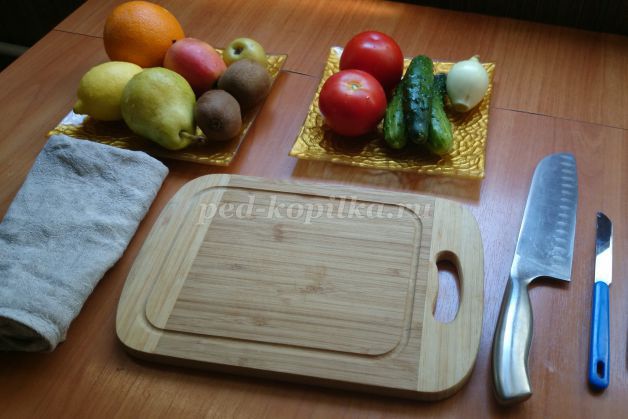
Working process.
Carving(from English carving - "cutting") - the art of artistic cutting on vegetables and fruits, as well as on wood, ice and stones.
Tips for a beginner "carvinger"
Not every fruit, vegetable is suitable for carving. So, for example, radishes should be large and bright, carrots should be even and smooth, and oranges should be very fresh. It is better to take apples with a smooth skin, cucumbers - even and with dark skin, pumpkins with rough skin have a denser and more convenient pulp to work with.
Decorations should be combined with the dish in color, as well as in taste. Meat dishes it is better to decorate with cucumbers, tomatoes, carrots, seafood - with lemons. Fruits will serve as a wonderful decoration for dessert, as well as an independent delicacy.
When choosing product combinations, give preference to contrasting colors - the compositions will be more enchanting. Red, green, yellow are favorites.
Fruits and vegetables for carving must be clean and dry.
There must be a golden mean in everything. You should not over-decorate dishes - the measure is important in everything.
1) The first vegetable to start with is a tomato. Cut it in half and cut off the unnecessary part.
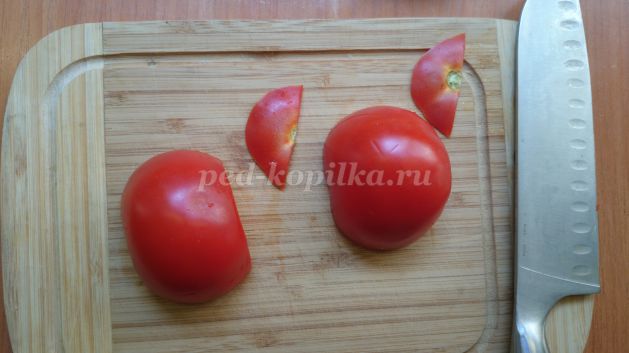
2) Then sharp knife Thinly slice one of the tomato halves.
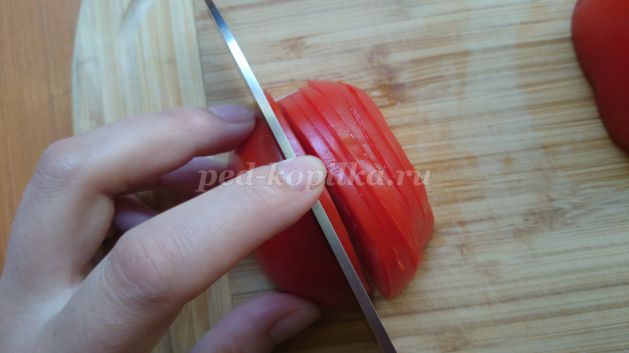
If it is small, then you can combine the two chopped halves into one. As in the photo.
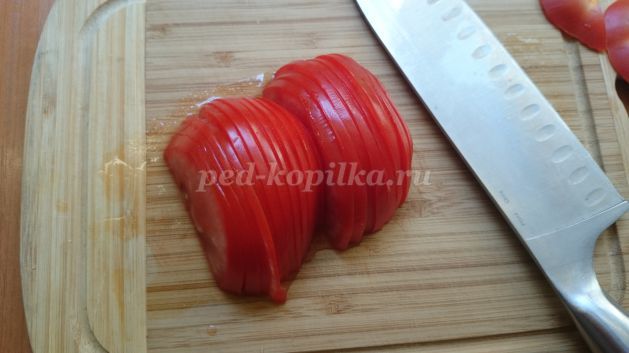
3) After that, we “stretch” the tomato as thin as possible and begin to twist it into flowers.
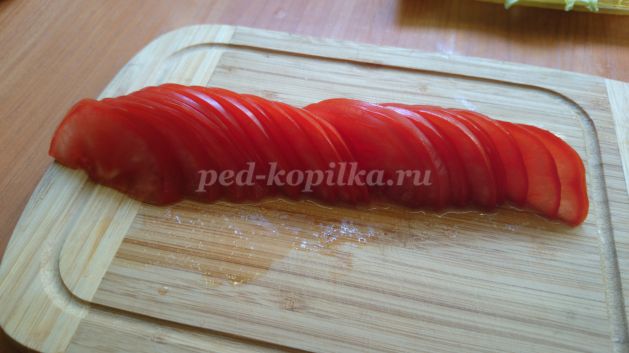
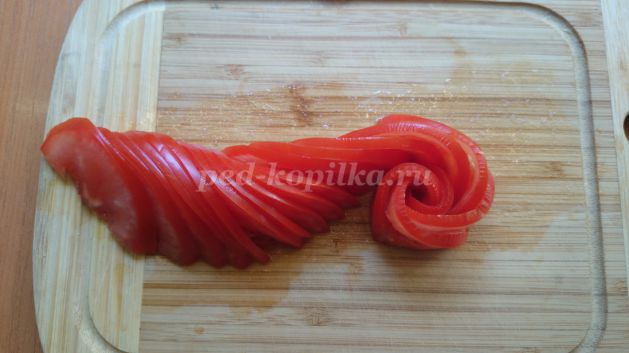
![]()
4) To carefully transfer the finished flower to the dish, you need to clasp it with both hands, pressing it from all sides.
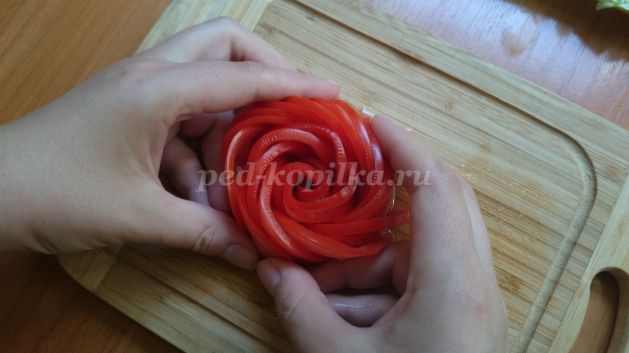
Ready! You can put a lettuce leaf on the bottom of the plate.
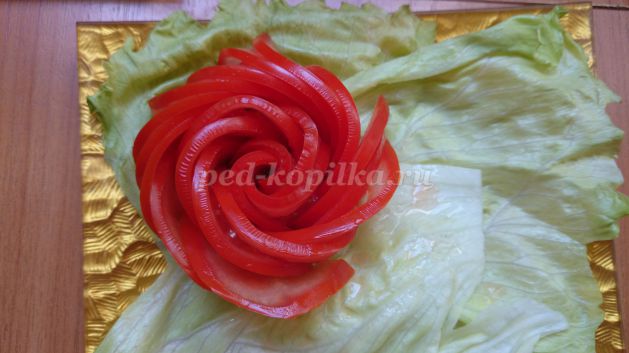
5) Our flower is missing something. You can add parsley or make cucumber bells. To do this, put the cucumber in the palm of your hand. With a sharp small knife, pointing it at ourselves, we cut the cucumber in the shape of a petal, plunging the knife blade to the middle. Then turning it, cut two more petals.
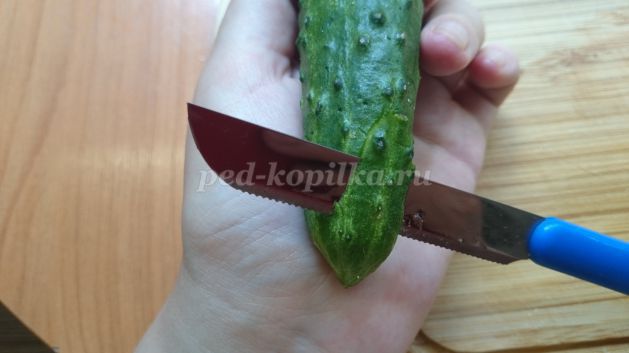
6) You should get a bell with three petals. To separate the flower from the cucumber, you need to turn it slightly and it will fall off by itself.
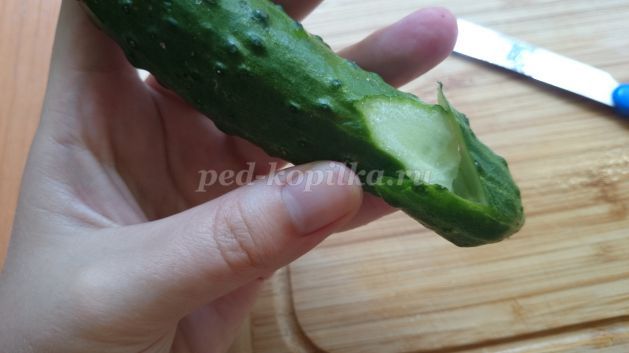
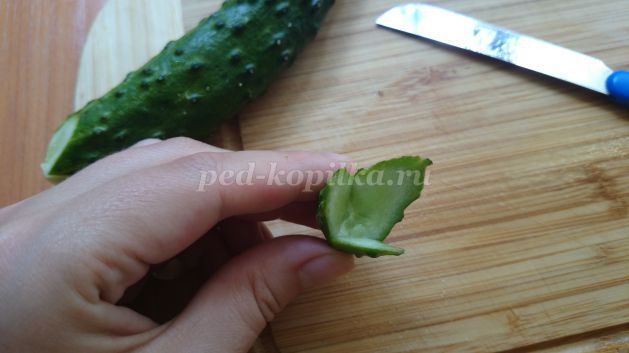
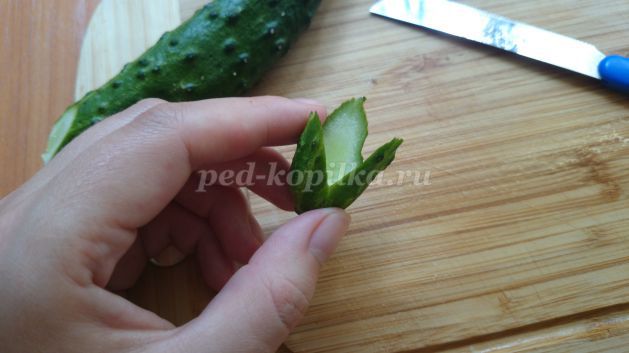
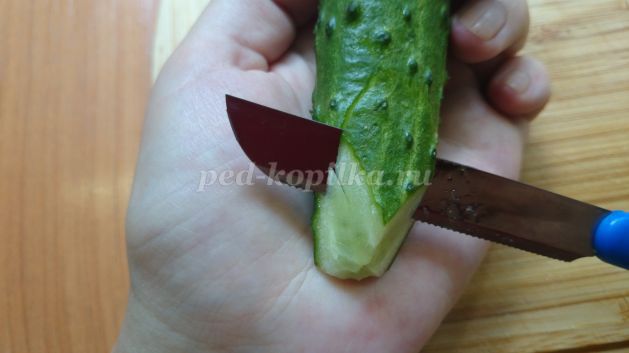
In the middle of the bells, you can add strips of pepper or olives.
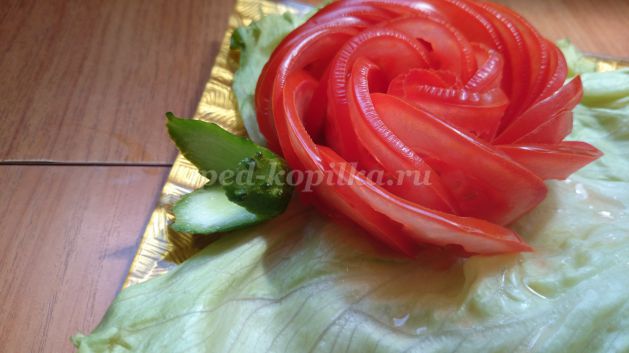
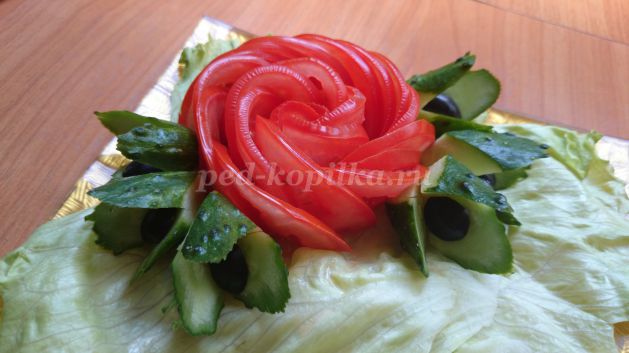
7) You can also cut thin strips of cucumber and, folding in half without breaking, complement our dish.
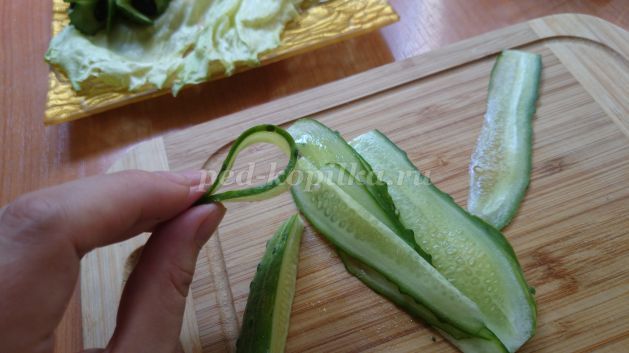
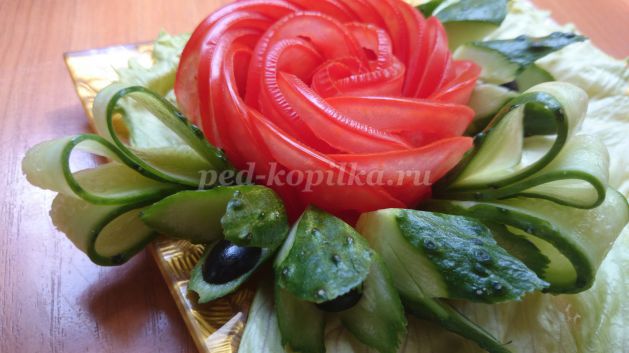
8) Gradually we move on to the bow. What can be done with onions? We can make a water lily out of it. To do this, the onion must be peeled, soaked in cold water so we don't cry. Then you need to cut it evenly with cloves, plunging the knife only to the middle. Upon completion, it will easily break into two halves.
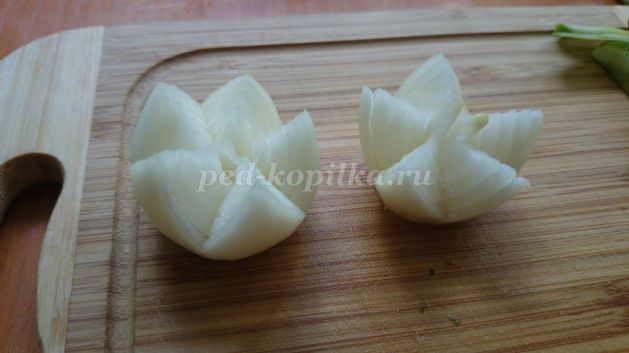
All parts of the onion must be removed and collected already forming a flower.
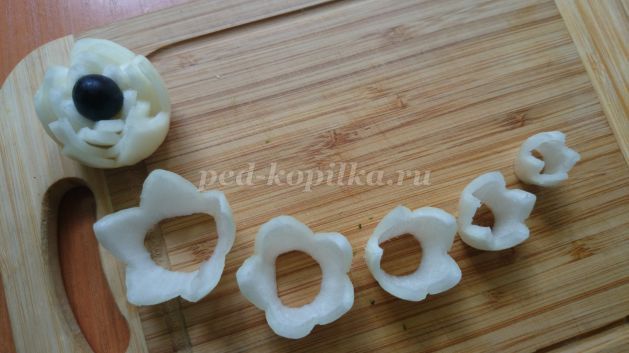
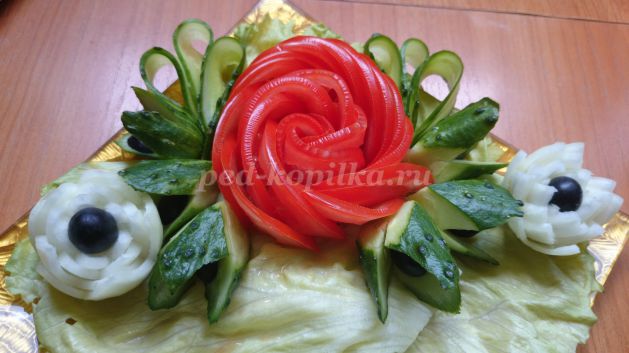
9) Our decoration for the dish is ready and you can add chopped vegetables or cold cuts.
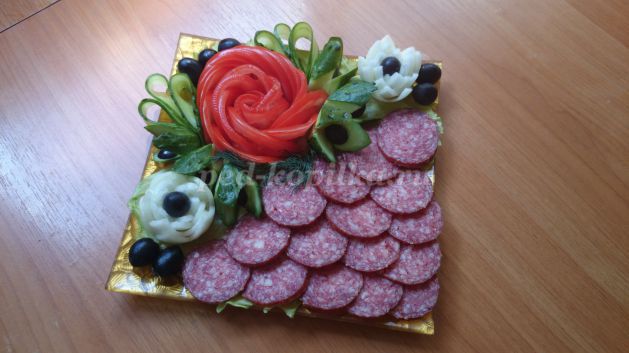
If you want to treat guests with sandwiches, you can use the middle for a tomato flower.
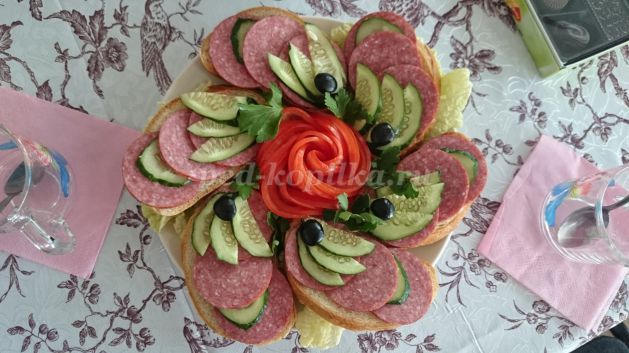
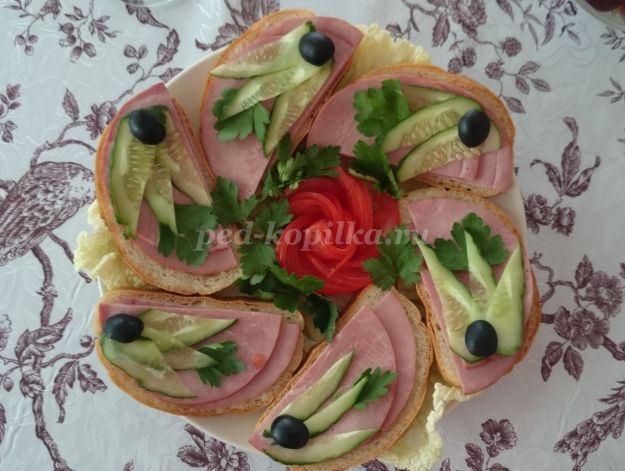
10) Vegetable decoration is ready. Now you can start decorating the fruit plate. To do this, we need to cut half an orange as described above.
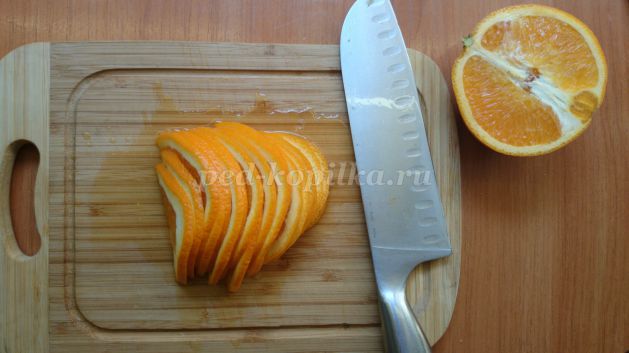
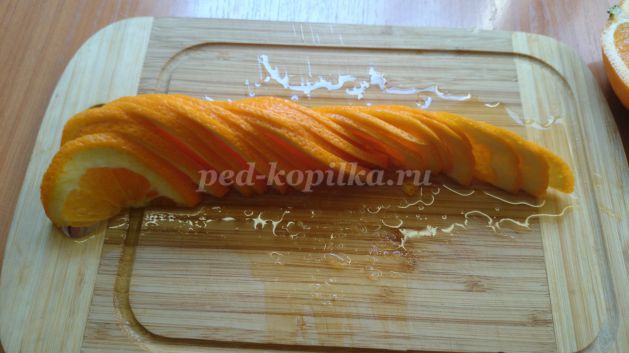
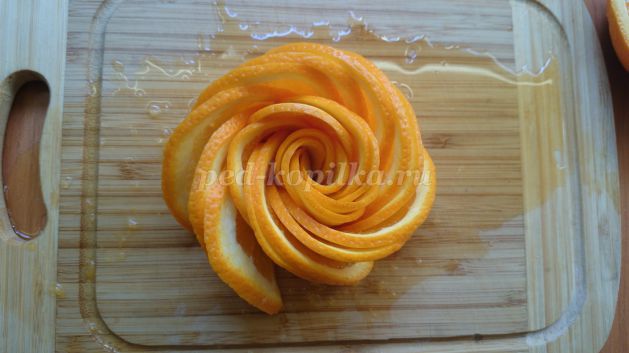
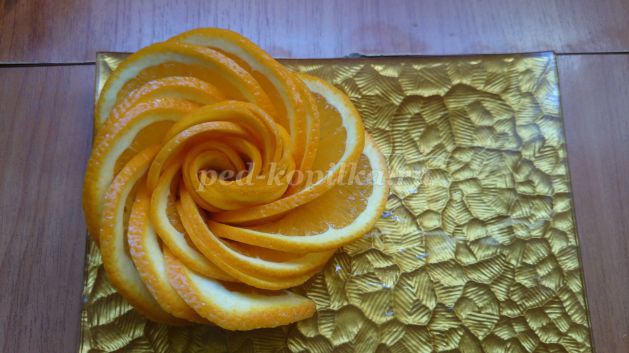
11) Do the same with the lemon.
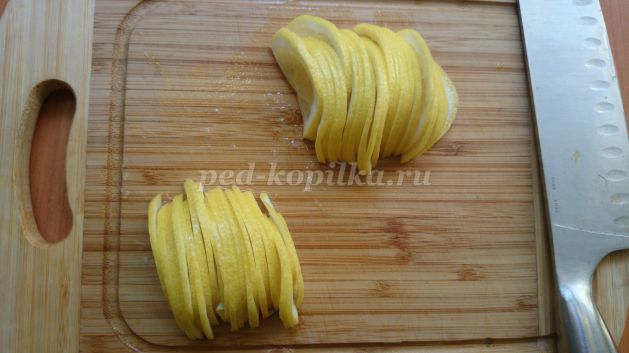
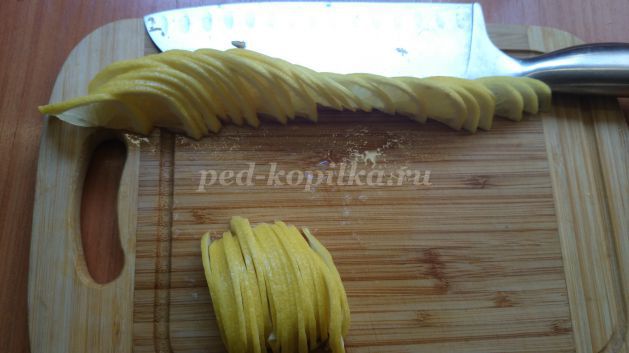
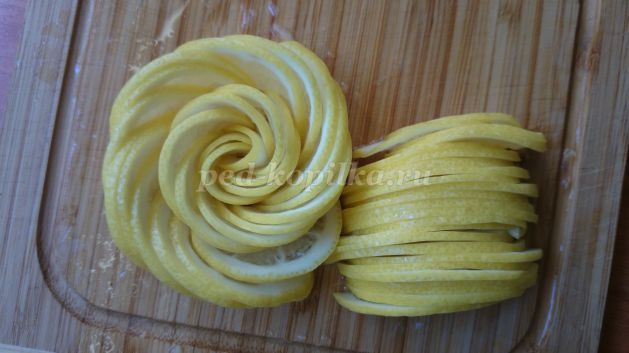

By the way, a lemon flower goes very well with fish products.
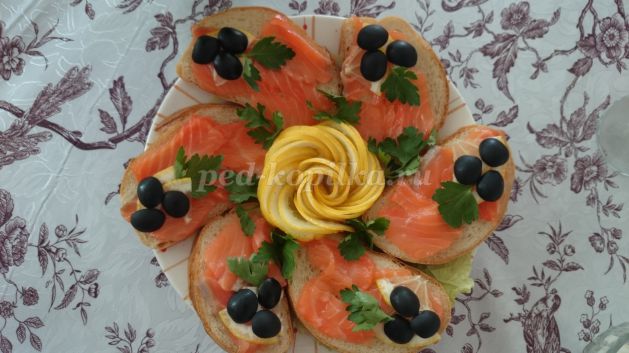
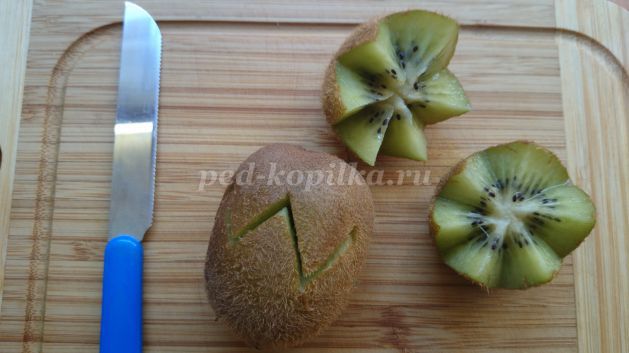
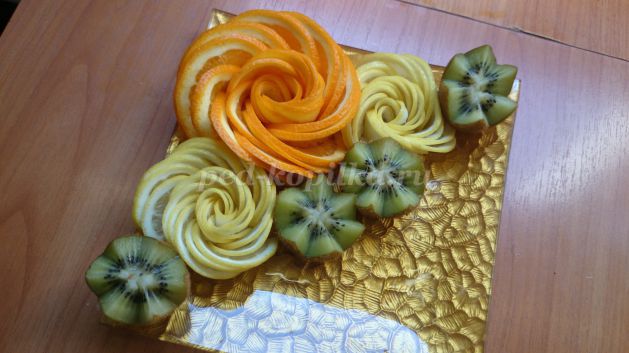
13) Now my favorite. Wings from apples and pears. We need fruit halves.
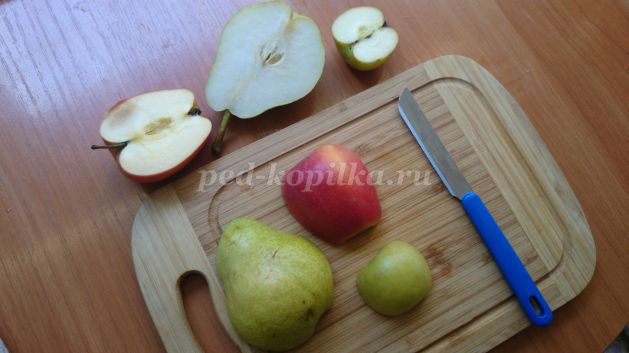
Visually divide the apple in half. I cut out a strip for you, for clarity. On one of the halves we find the middle and immerse the knife slightly deepening. To make it easier to imagine, we kind of cut off the peel. You need to get half a petal.
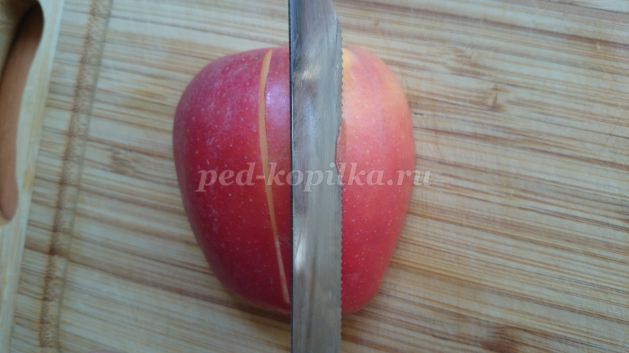
Then on the other side we do the same, but we cut exactly to the made corners. Care must be taken not to cut off the excess. Got a leaf.
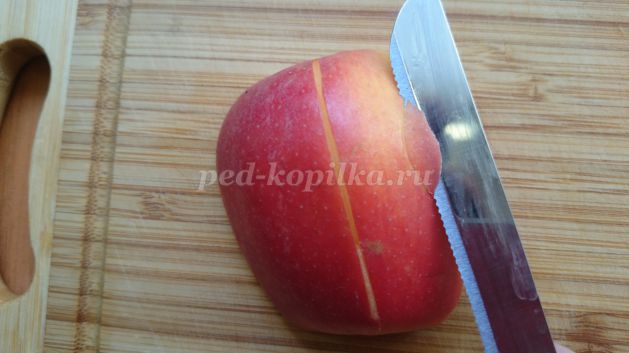
This review presents an interesting kitchen helper. In their language, this is called Slicer, that is, a kind of “grater-slicer”, “vegetable cutter”.
The device is mechanical. It functions solely on muscular strength, but it is quite complex and quite functional.
I will try to show how the whole thing works, using the example of my signature “Chinese” salad, which consists of several types fresh vegetables, chicken and chopped omelet.
There will be a video and a lot of photos.
Delivery and price
The cutter came to my house by a courier from Nova Poshta International. I didn’t have a track, but after talking with the manager until the moment I received it, 15 days passed.For residents of Russia, delivery may be faster, as I was told that the seller has a warehouse here. Although on the store page, nothing is said about this.
The price of the cutter at the time of sending and receiving was a little over 30 USD. But the seller kindly agreed to cut the price a little so that the offer would be at the level of the most profitable on Ali.
Packaging and equipment
A weighty box came to me, which in size can be mistaken for a shoe box. Its dimensions are 35x17x14 cm.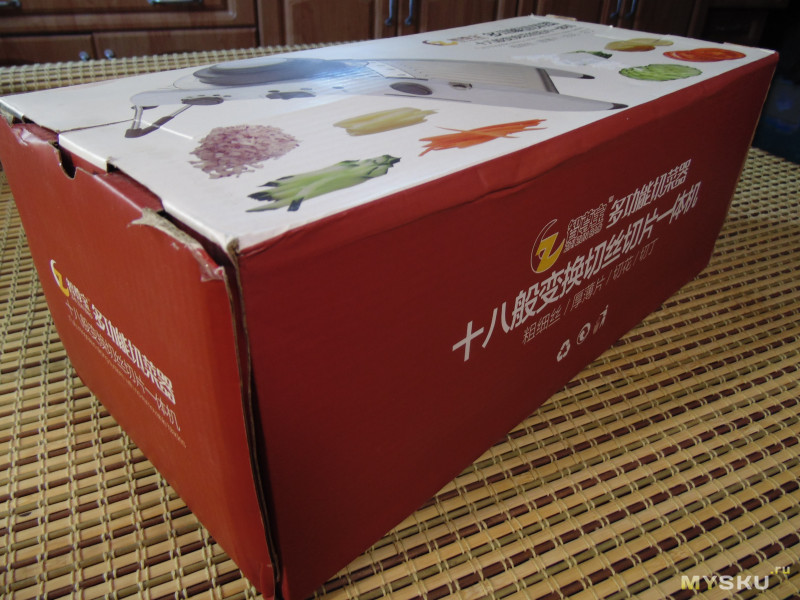
The cardboard is of good quality. Printing is normal. Colors, images and inscriptions are modest. During the trip, almost nothing was crushed.
The device in the box did not hang out, it was in the package. 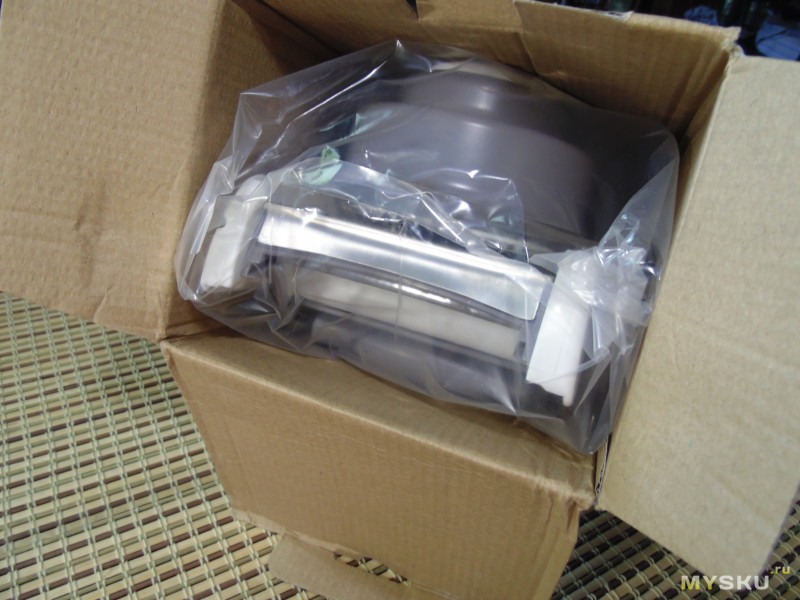
In addition to the slicer itself, the delivery also includes instructions (hieroglyphs). 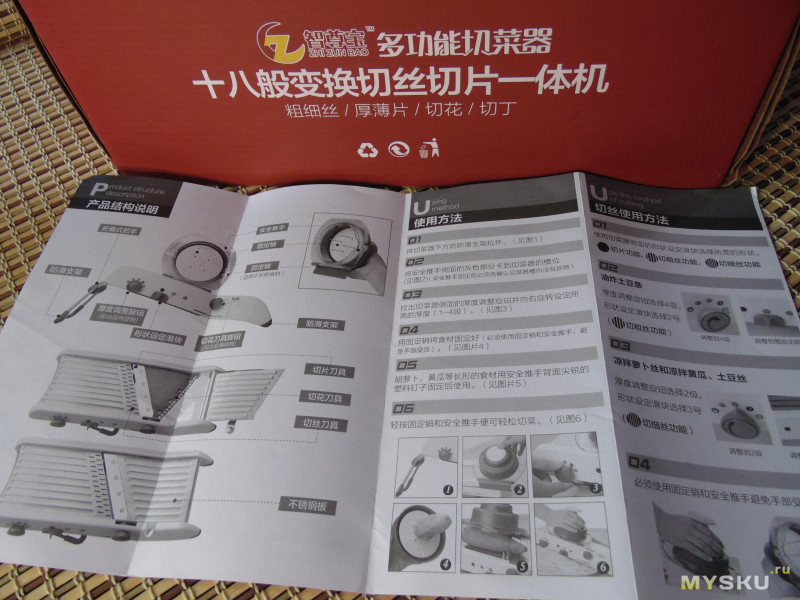
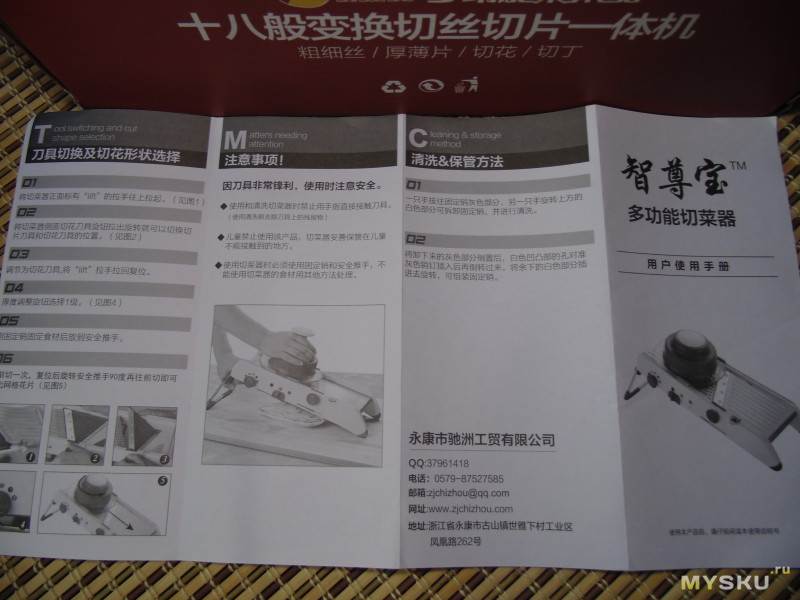
Appearance and materials
The tool is large.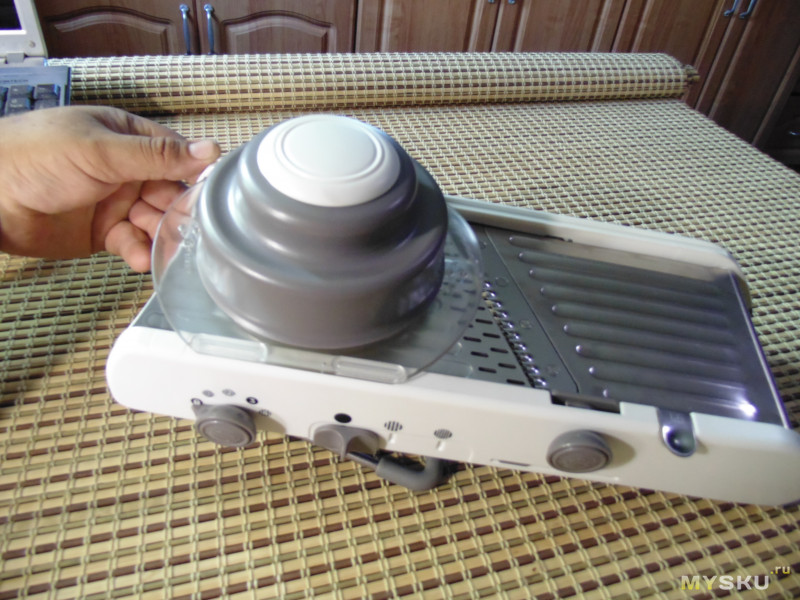
And heavy.
It weighs exactly one kilogram. 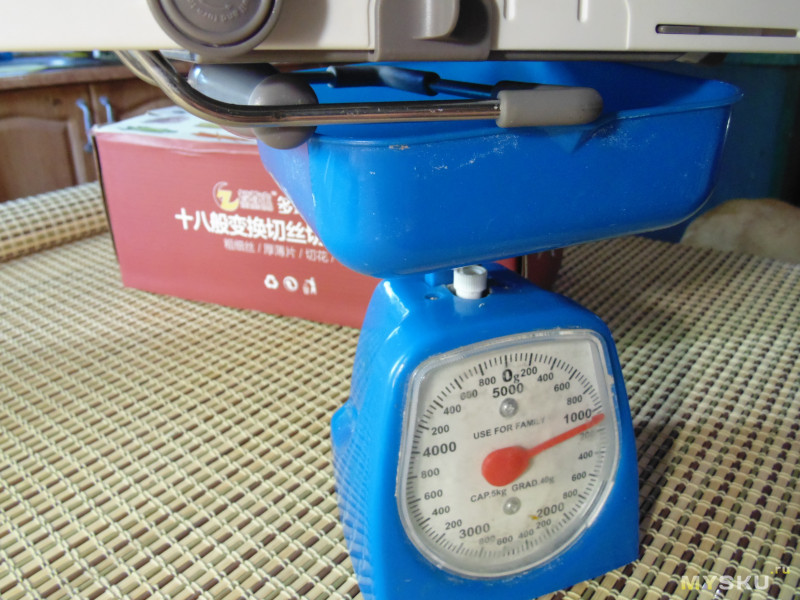
As Razor Boris said ... well, you know ... like: "Mass is good, mass is reliability."
The guys did not waste time with materials.
Large metal plate 0.8 mm thick. White and gray plastic housing 2.5 mm. Transparent plastic vegetable holder 2.9 mm. Metal leg - about 5 mm in diameter. 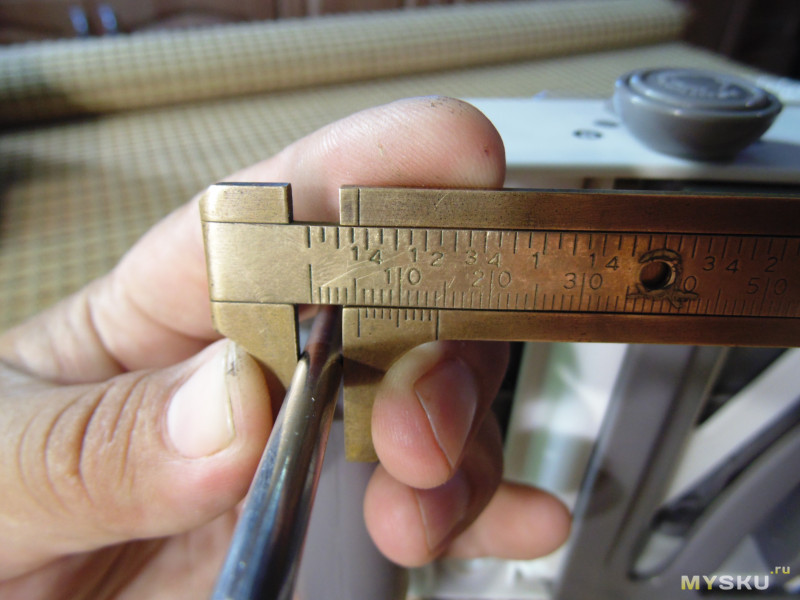
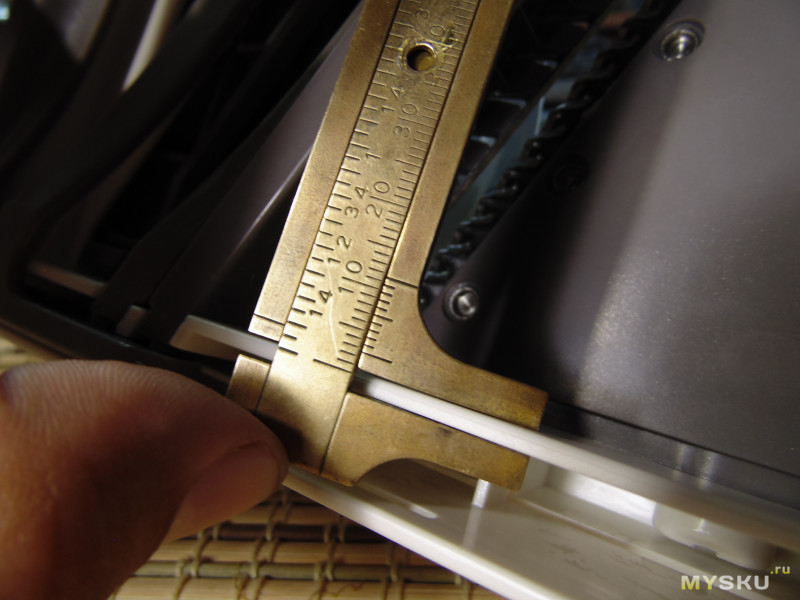
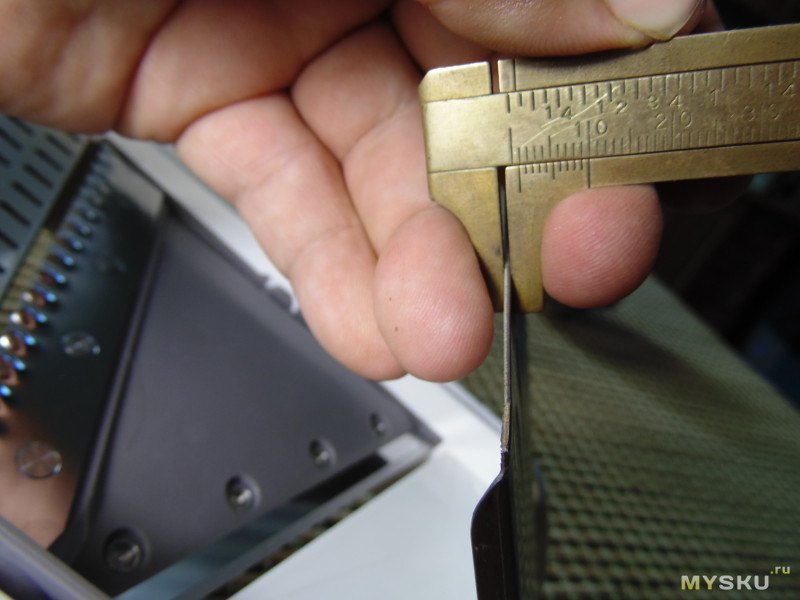
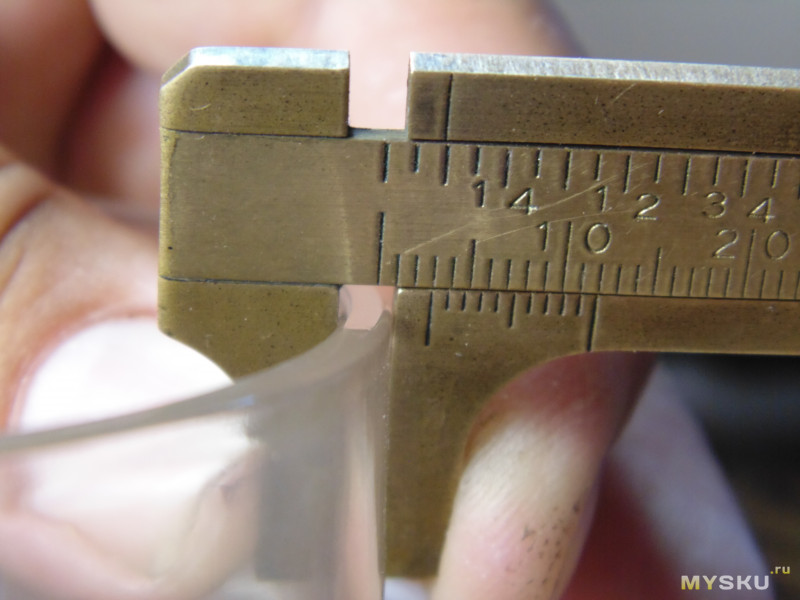
The main frame, most of the moving parts are made of plastic (ABS claimed). I liked its quality. In addition to a decent thickness, it is not oak. Where necessary, the walls are doubled, equipped with stiffeners. 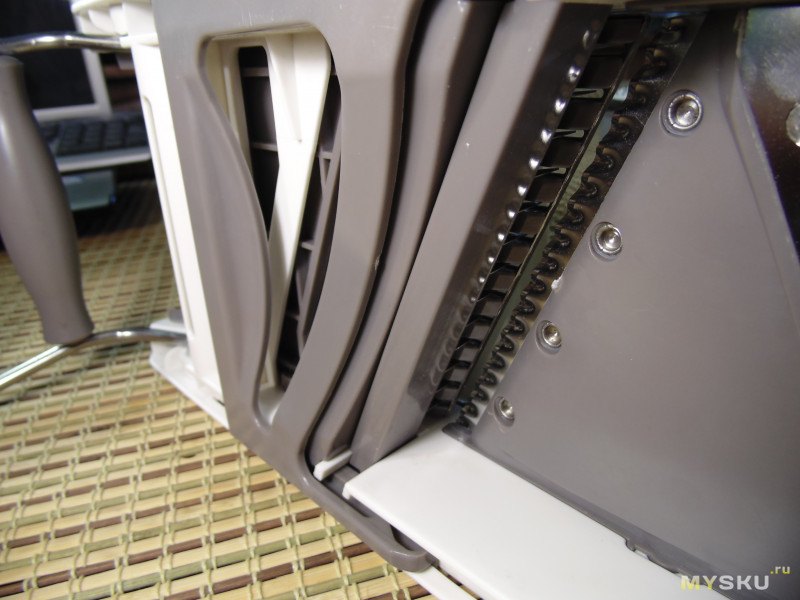
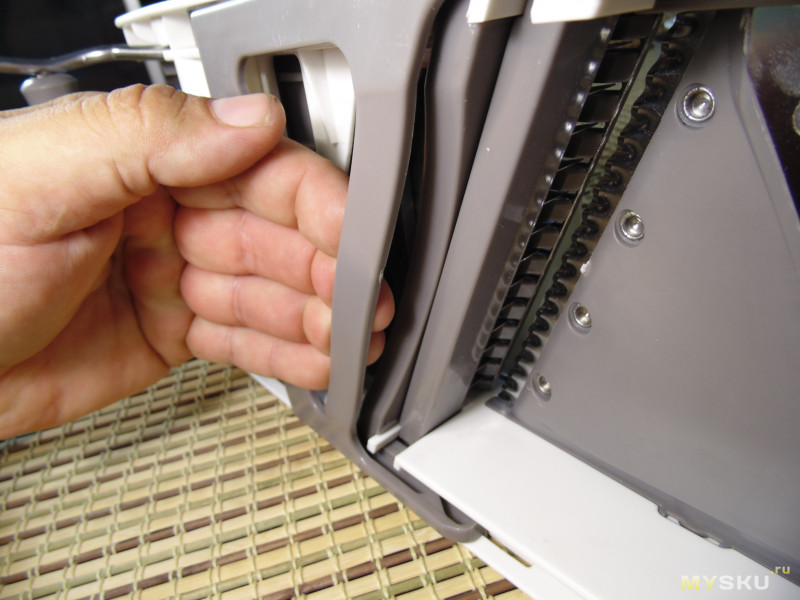
In general, the product for some reason reminded me of the conversion products of the Soviet era.
The execution of plastic injection, let's say - 5 with a minus or 4 with a plus. There are traces of sprues in some places, in some places there are “casting seams” type. 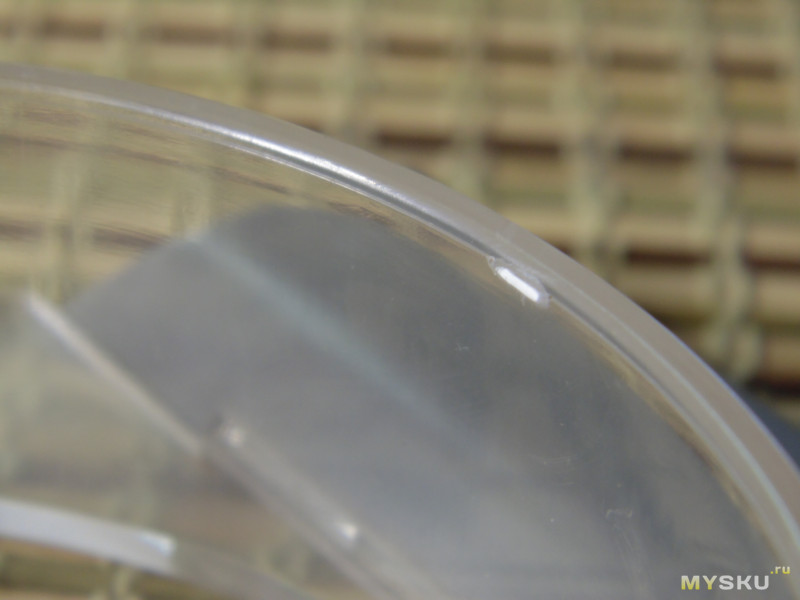
I liked the color of white - it is here without “cyanosis”, I would call this white “milky” (Bosch loves this, it seems to me). Plastic is not glossy, but quite smooth - the golden mean. Washes great. 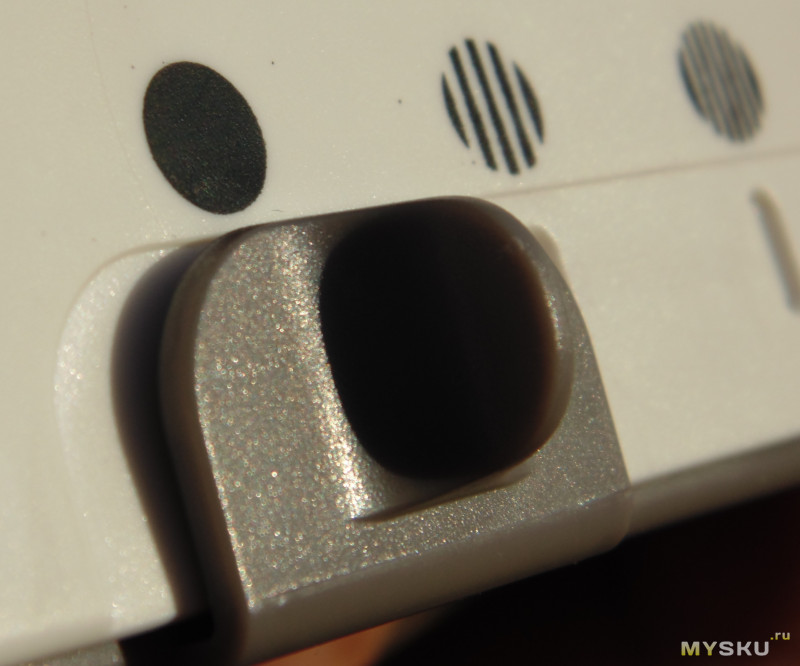
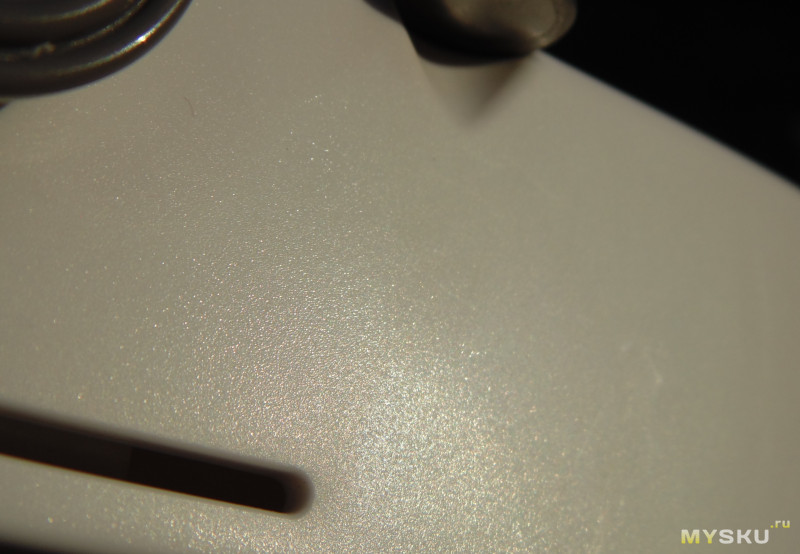
The working surface areas are made of stainless steel (for 3 days of use and repeated washing, nothing rusts, nothing oxidized, nothing stained). Processing of metal type "satin". Burrs were not found. 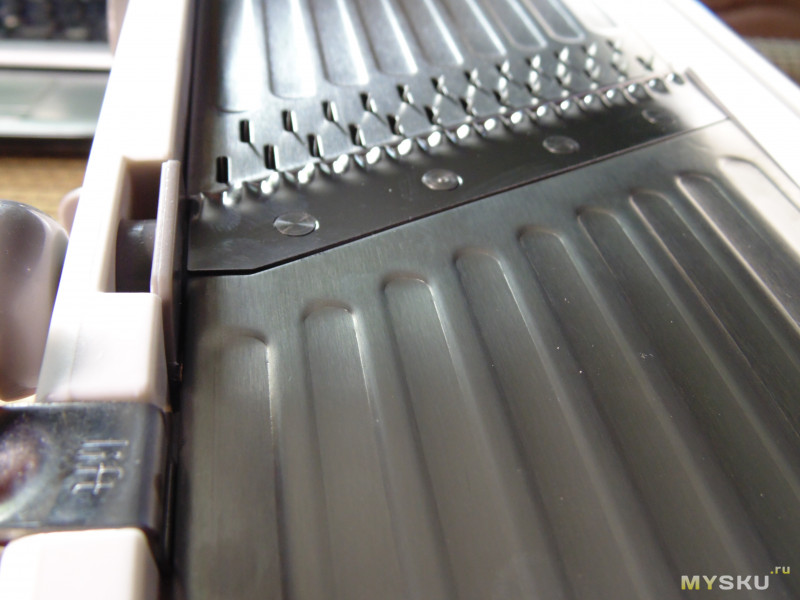
On the one hand, the bed is equipped with a folding bracket that works as a leg. This element makes it possible to slide a plate or bowl under the cutter. 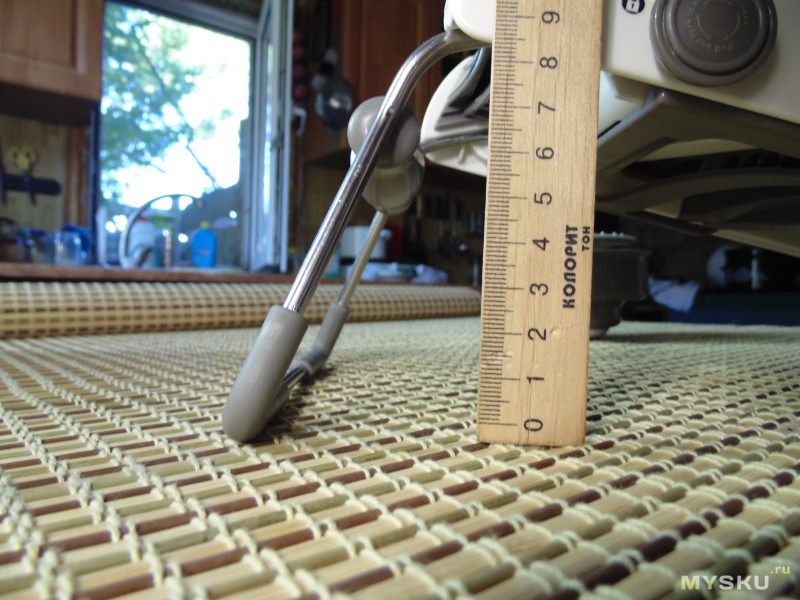
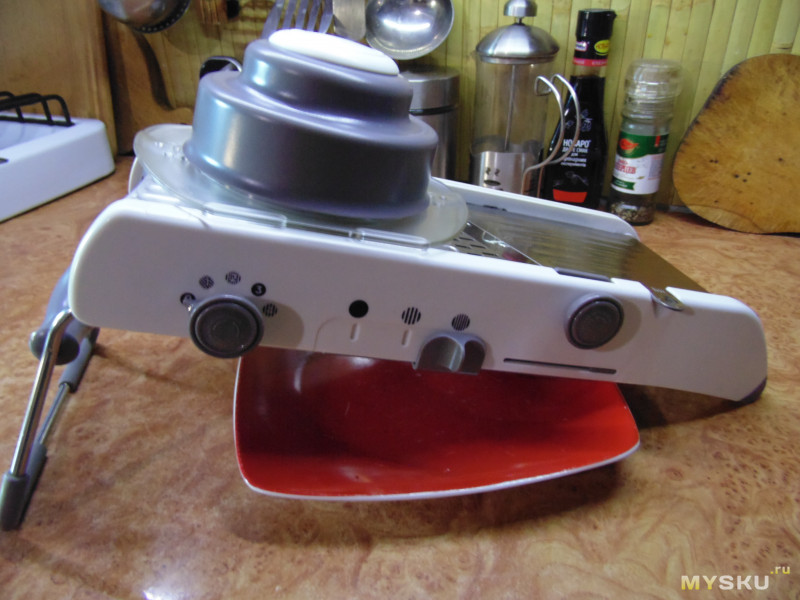
Also placed on the leg handle. A convenient full-size thing, it helps out a lot during work. 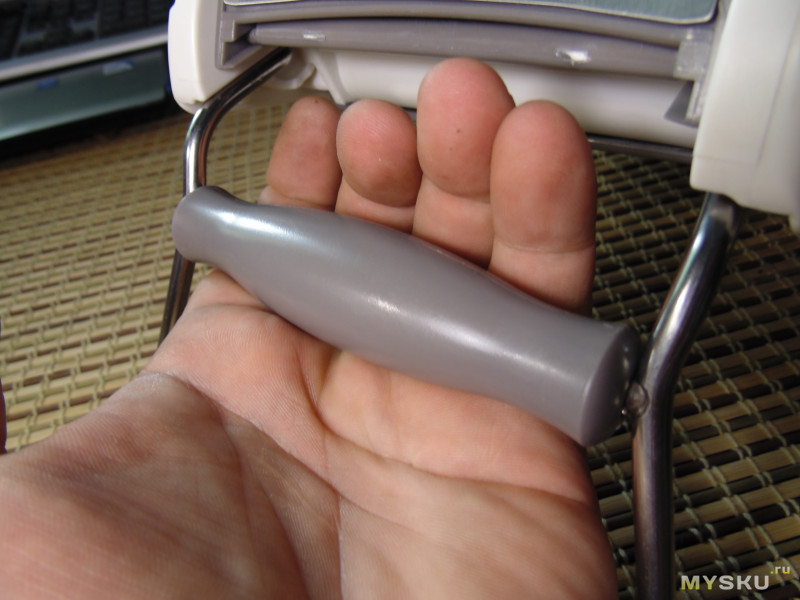
To prevent slipping on the table, there are protectors made of thick rubber or soft plastic on the leg. From a similar material there are inserts on the other side. 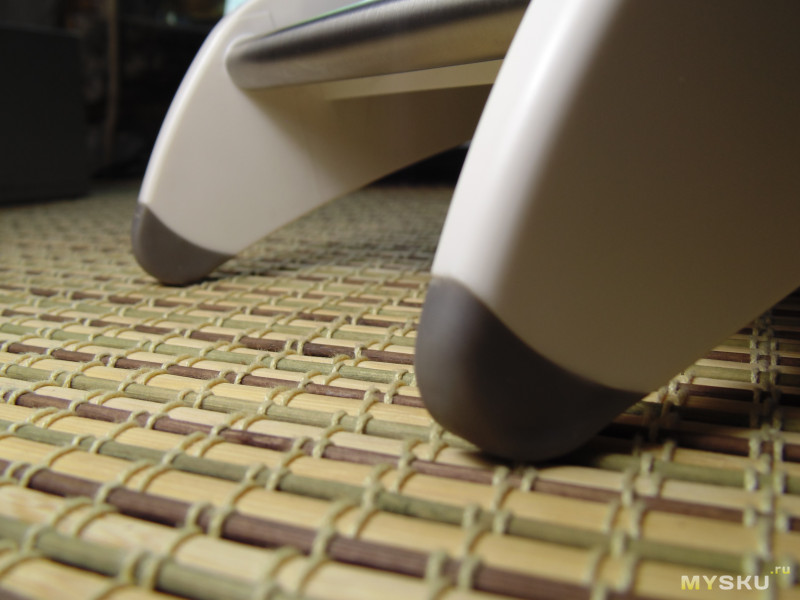
Design and functionality
The main feature of this "grater" is the available adjustments.On one of the long sides there are 2 twists and 1 slider.
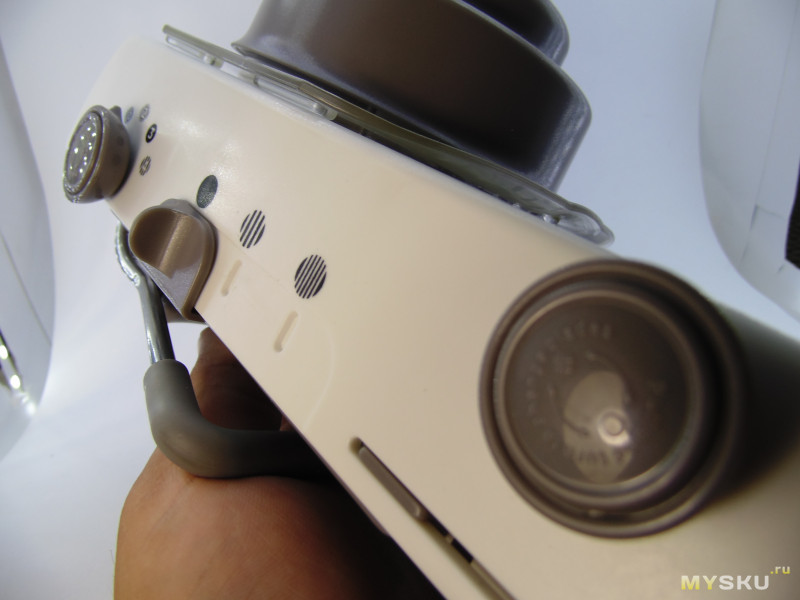
The first twist is responsible for lifting the support platform. By pulling out the spring-loaded handle, we have the opportunity to choose one of four options for the thickness of the cut. 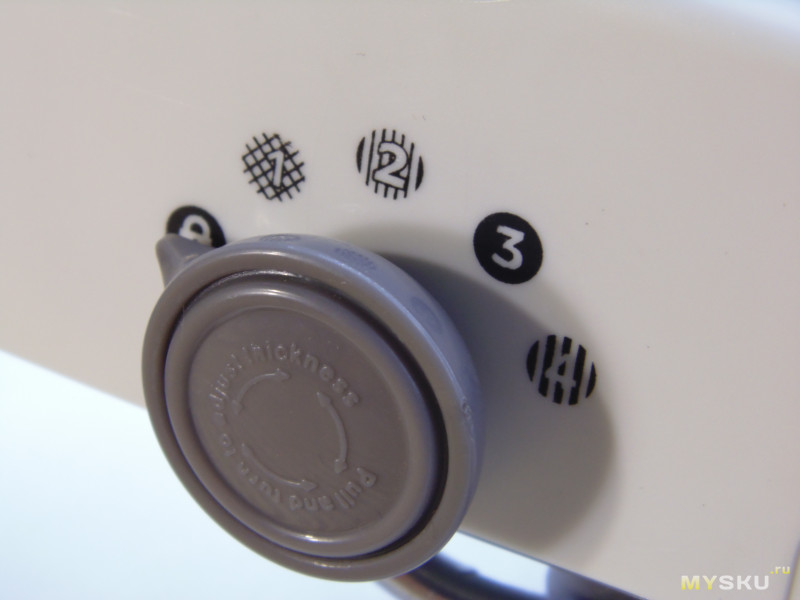
On average, slices, straws or sticks are obtained with a thickness of 2 to 10 mm ( exact numbers differ slightly from the properties of the cutting object and the pressing force).
There is also a starting position (with a lock). In it, all cutting elements are below the support platform and do not pose any particular danger to anyone.
The slider is responsible for reaching the surface of "shark fins". These knives break type chunks into bars, noodles or straws. In the first position, only one row of vertical canvases is activated. 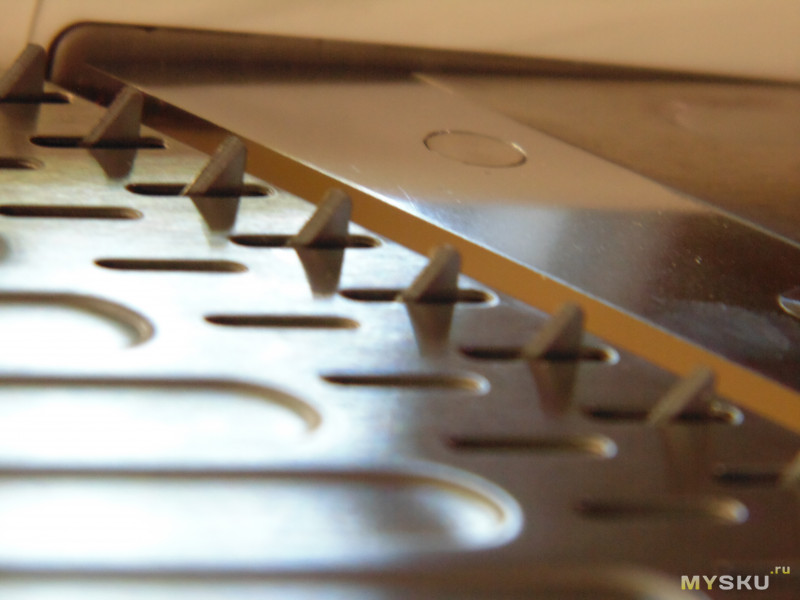
In the second position, intermediate blades are also added, and the product flats are twice as narrow. 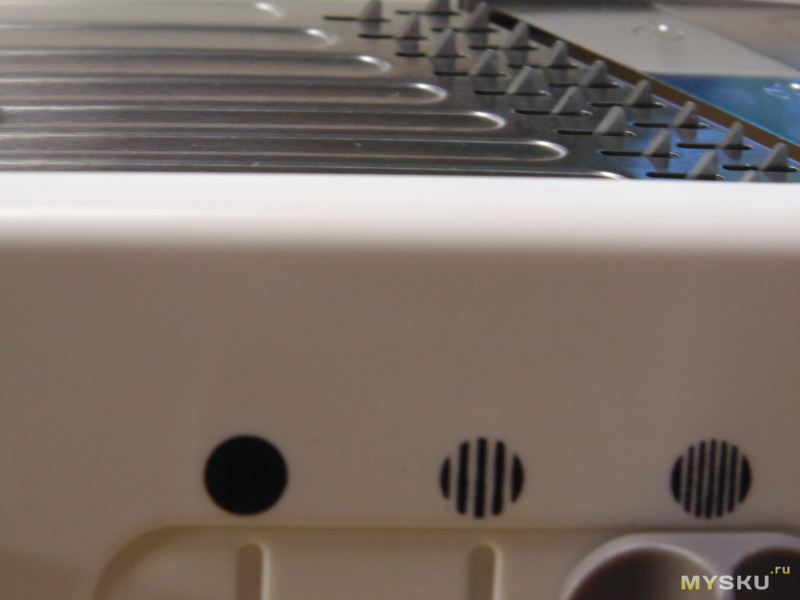
Another twist is designed to select the working cutting blade. There are two main knives:
Flat
Wavy.
With flat everything is clear. But with a wavy knife, you can get not only more aesthetic slices, but also achieve the same result as on a regular “grater” (in the form of a perforated plate). To do this, set the platform to the minimum height position 1 and make short movements.
For example, I tried hard cheese do. It also turned out with carrots, apples, cucumbers… 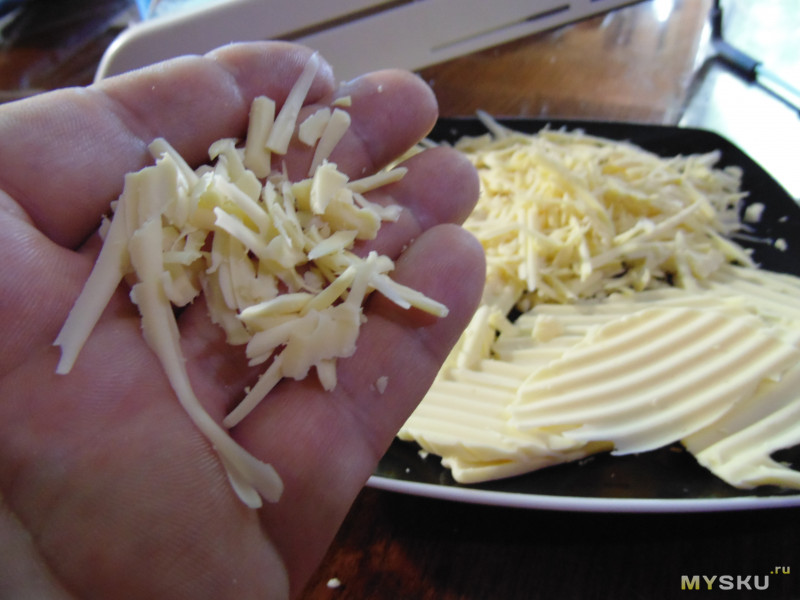
To change the blades, you need to lift the locking plate. 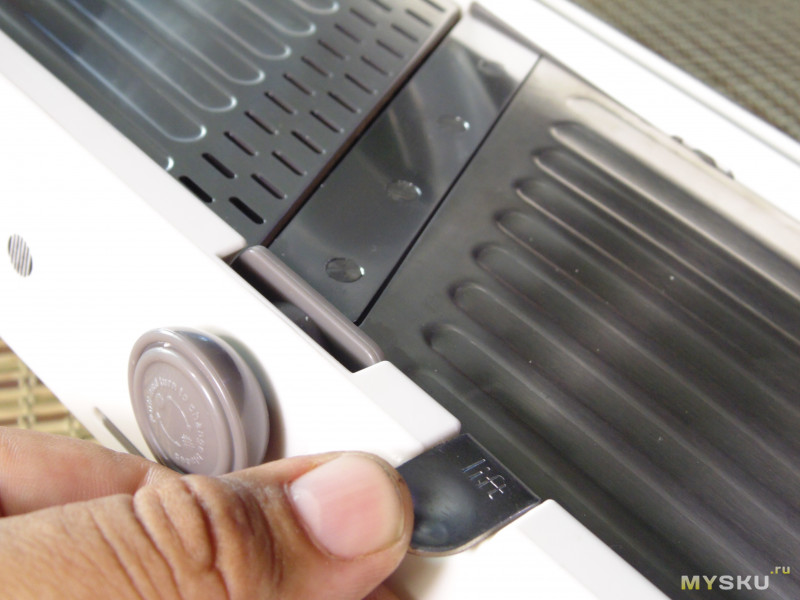
Then you need to pull the spring-loaded handle towards you and turn the knife holder 180 degrees. 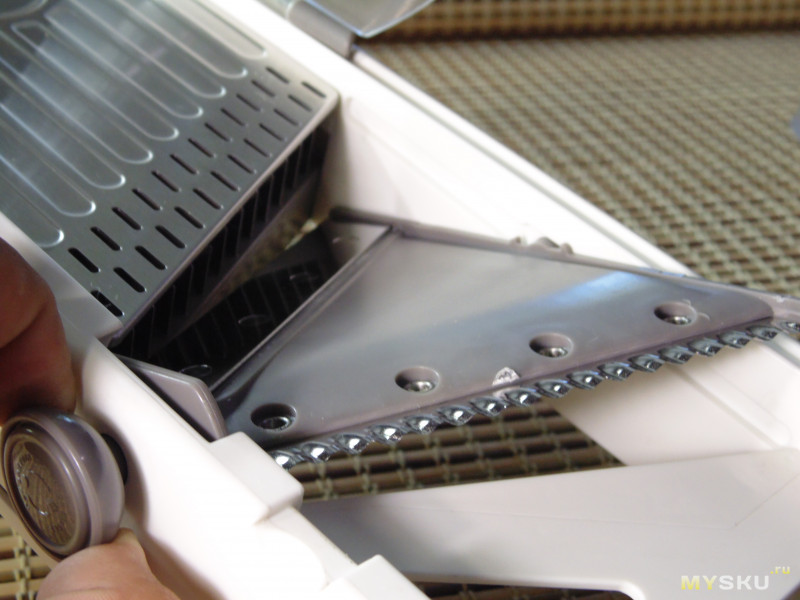
The flat knife has an edge with transverse risks. 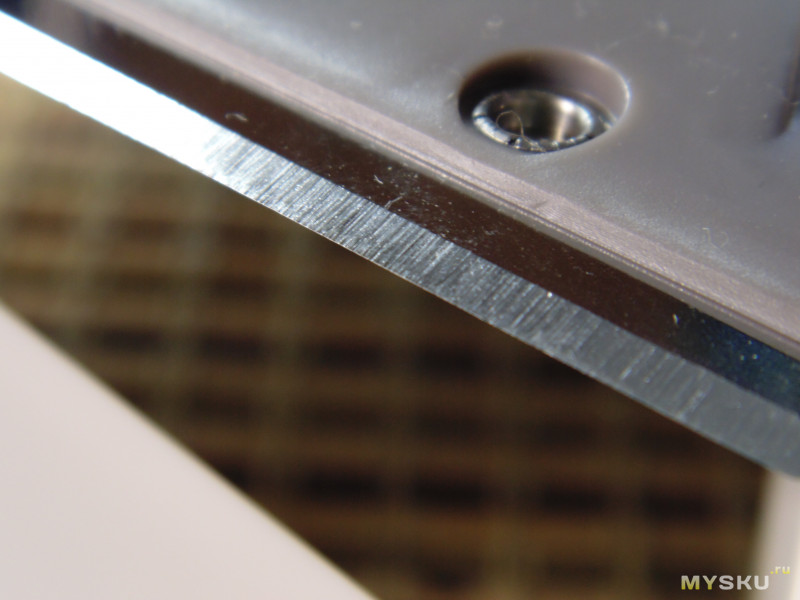
Sharpened, it seems, well. But he still crushed the soft pink tomatoes in my skin.
With the rest of the products with which I tested the device, it worked perfectly. With solid objects, such as carrots, there were no problems. Soft ones also went well, for example, I tried mozzarella for a change. 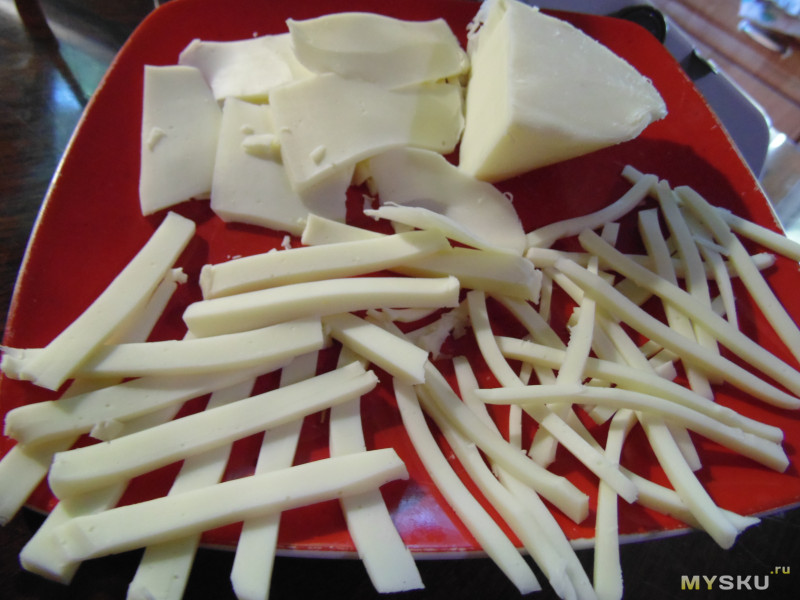
Salami, of course, is not at all like that. But there the sausage was too loose. And it's not intended... 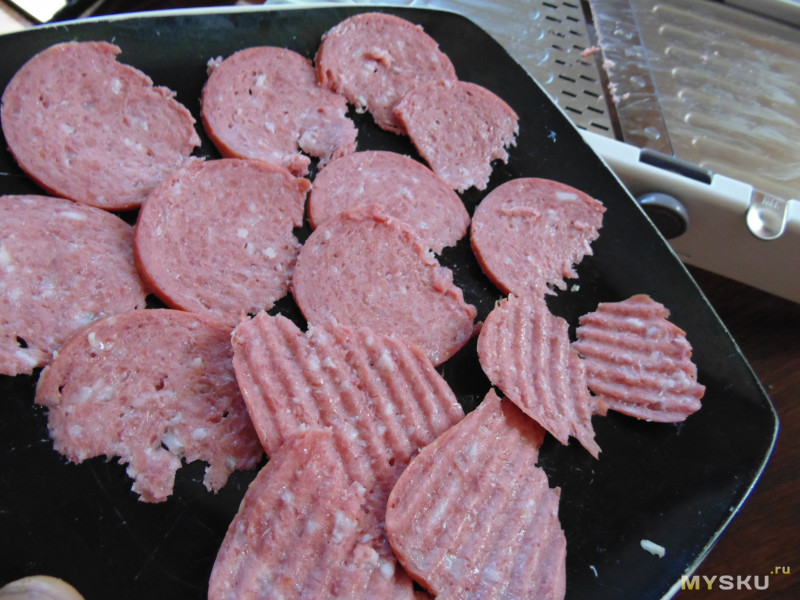
I think ham, thick boiled potatoes without a shell, servlets and other options should be cut normally. With cheese - I don't know. More likely no than yes.
By the way, the knives are fixed like rivets. Probably, it would be better to do something threaded. 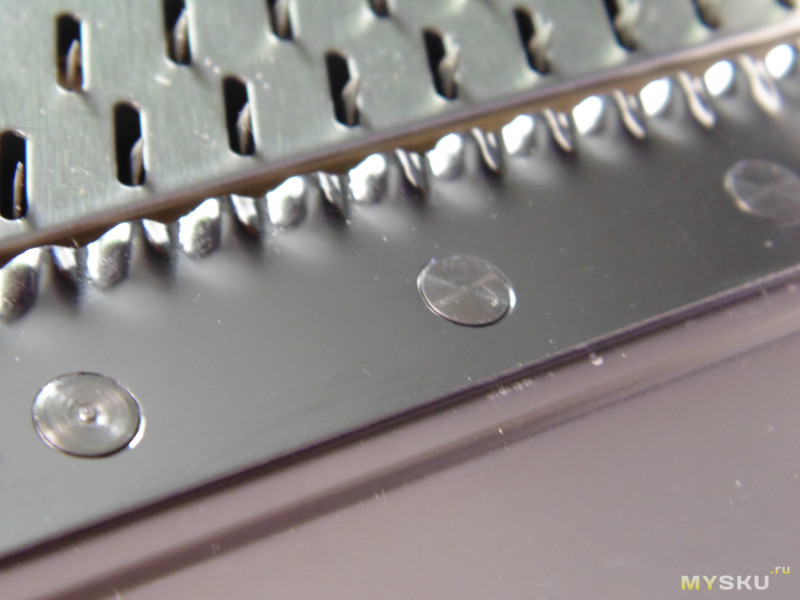

It is convenient to cut any root crops with the help of a holder. 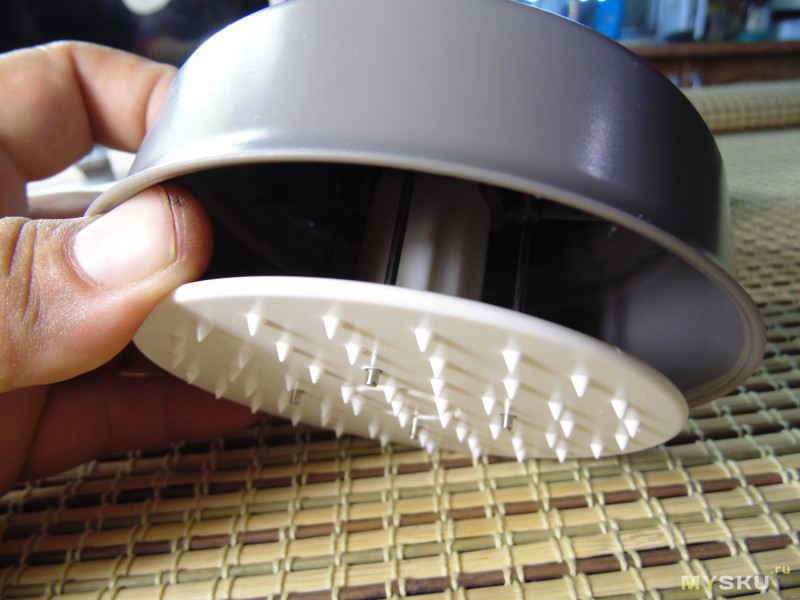
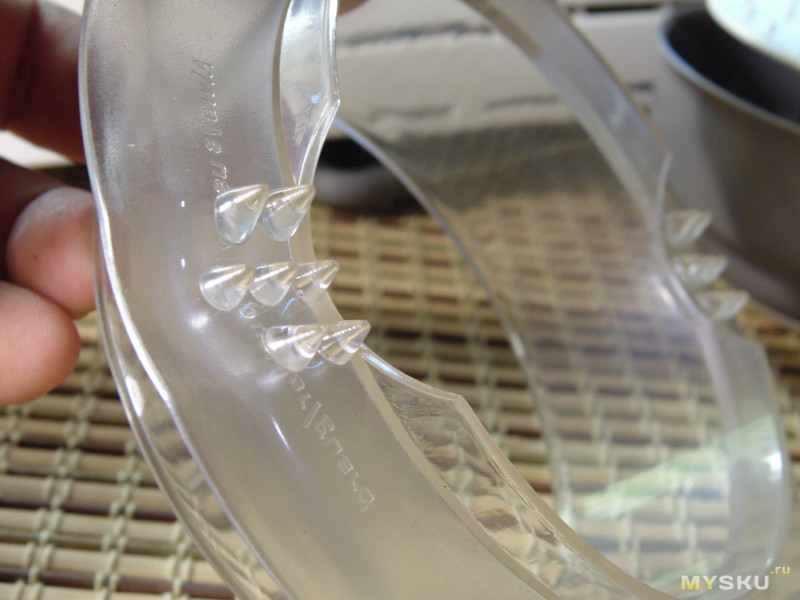
I had never used them before, and they seemed uncomfortable to me. But it's not.
The holder inserts into the groove of the case and walks like on rails. 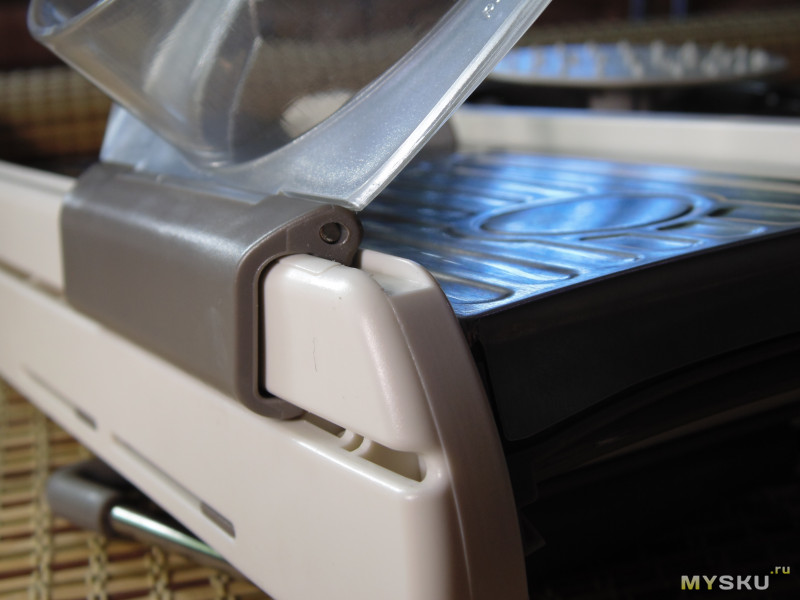
It cuts the object almost to zero, and there is no danger of rubbing fingers into the salad. 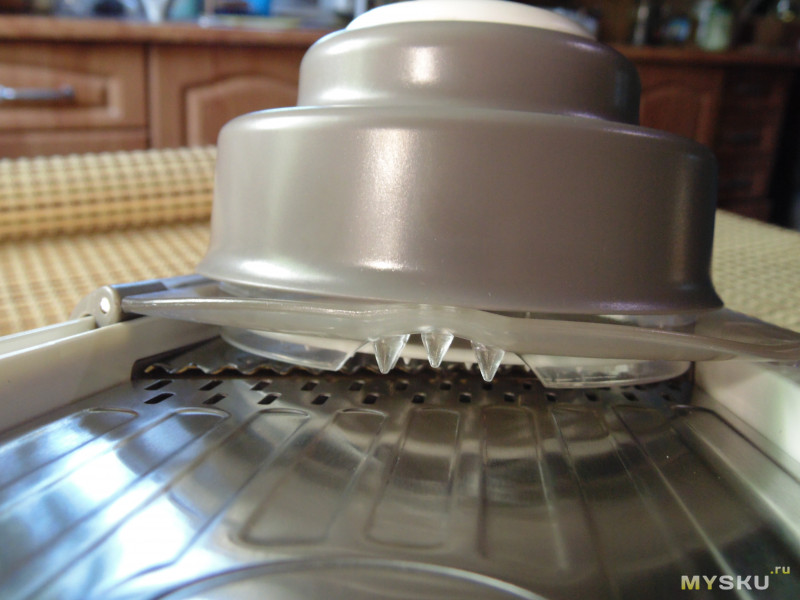
Including you can rub with long straws or long tongues - for example, cucumber, carrot, elongated potato tuber.
I chopped potatoes like chips. Bars and leaves. 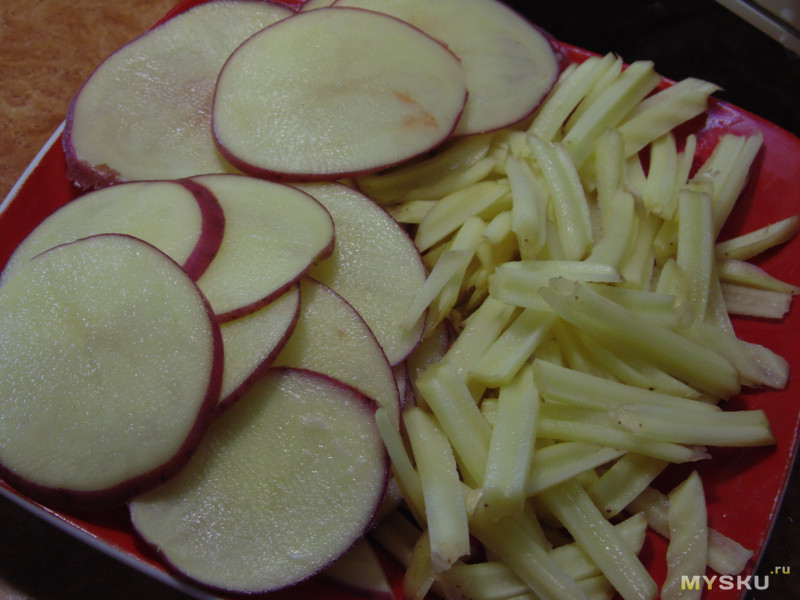
Here I cut a ripe soft banana (it’s clear that it’s easy with a knife - I just did it to understand the possibilities). 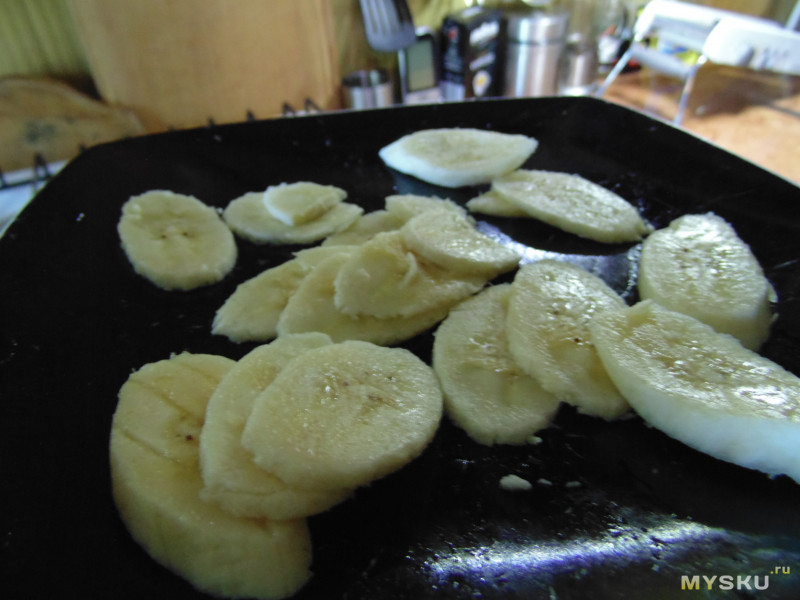
An Apple. I tried fine rubbing and curly slices. In the presence was only very loose, hard varieties will go well, I'm sure. 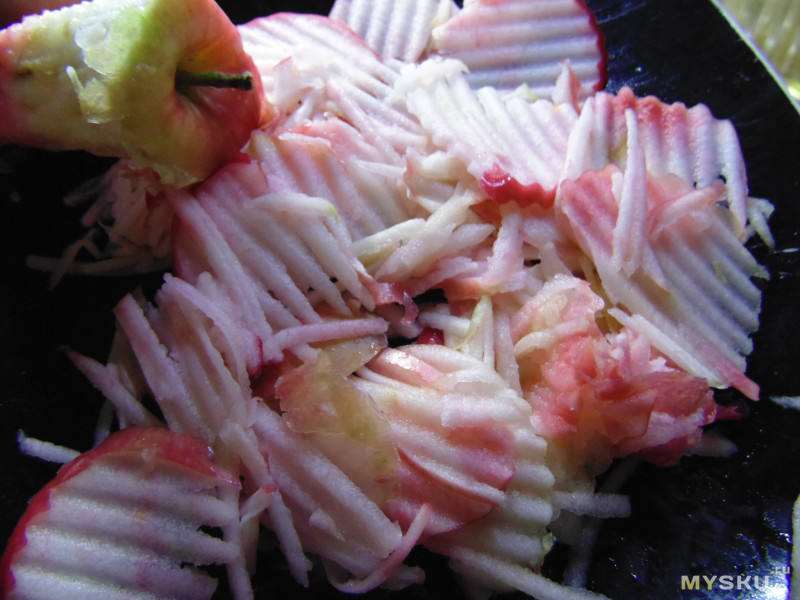
Also quite effectively crumbled: cucumbers, kiwi, tomatoes, carrots, white cabbage, Bell pepper, onion ... Something is photographed and presented below in the recipe, but for example, the carrot was only in the photo ready-made lettuce, but there is it on the video.
We cut the salad "almost Chinese" from fresh vegetables with meat
I’ll warn you right away that I’m a complete amateur in cooking. I’m sure I’m doing something wrong, I’m not posting according to Feng Shui, I’m using the wrong ingredients, I’m eating with a fork ... and in general, perhaps such a salad cannot be called categorically Chinese ...That is, I immediately tell you that I make this salad “based on”. Everything.
So what am I using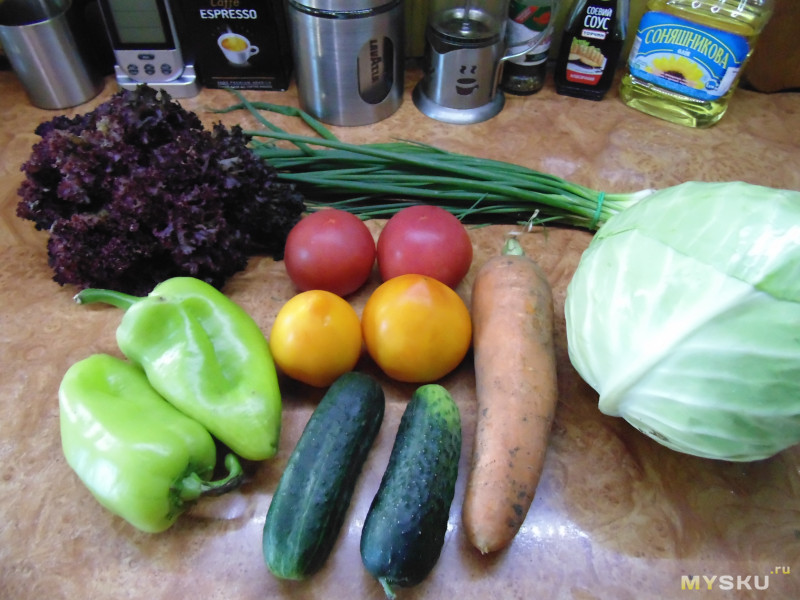
For the salad body:
- Chicken breast (from one medium-sized carcass).
- Tomatoes small 4 pieces.
- Cucumbers - 2 pieces.
- Sweet pepper 2 pieces.
- Carrot large 1 piece.
- White cabbage (I usually use red) - 200-300 grams.
- Salad purple- one bush (took only beautiful bright tops).
- Green onion - a small bunch.
- Eggs large 4 pieces.
- Parsley 1 bunch.
- Dill 1 bunch.
- Basil 8-10 leaves.
- Mustard "Russian" - 1 teaspoon.
- Sugar 1.5 teaspoons.
- Garlic - 3 large cloves.
- Lemon juice - 1.5 tablespoons.
- Soy sauce - 100 ml.
- Water - 100 ml.
- Vegetable oil 100 ml.
- Sesame - a couple of tablespoons.
1. I always start with the sauce. I cut greens finely. I crush the garlic. I put everything in one container. And I send it to hell room temperature. 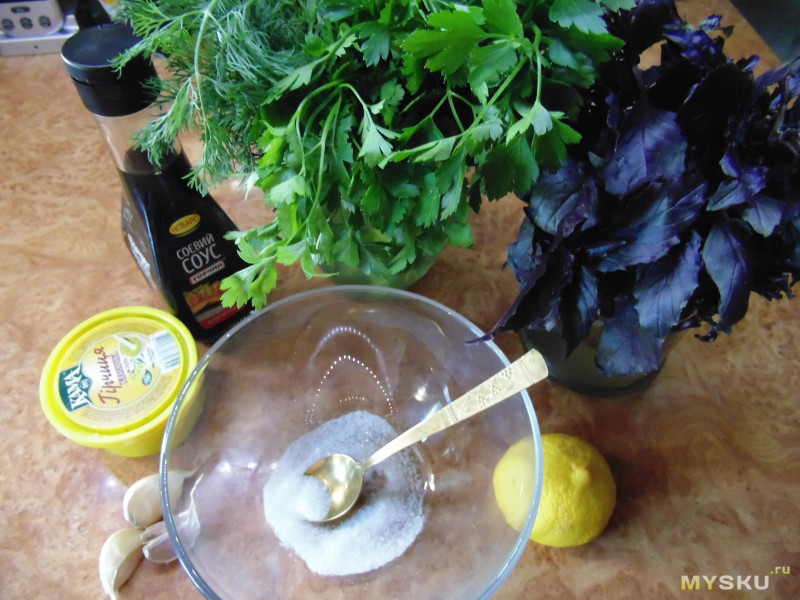

2. Making an omelet. Mix eggs with two tablespoons vegetable oil. Then I fry thin omelette pancakes under the lid - in a large frying pan it turns out 2 calls and 2 pancakes. 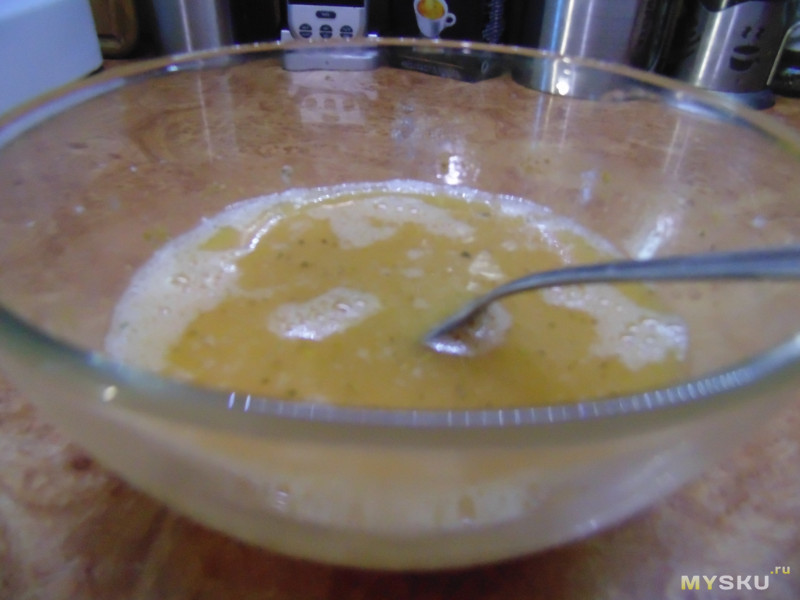
3. I cut omelette pancakes with noodles / straws. 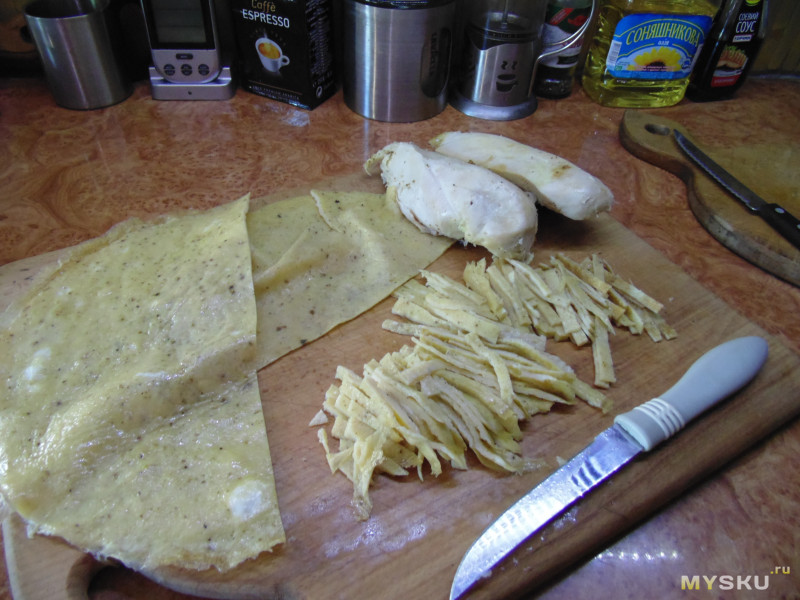
4. Cut the chicken (I cut the breast from the one I cooked in the microwave on the grill mode) into strips - I prefer to tear the poultry meat.
5. Put the meat in the center of the dish (by the way, my friend's family likes to use pork with mushrooms here). And lay out an omelet in two sectors. 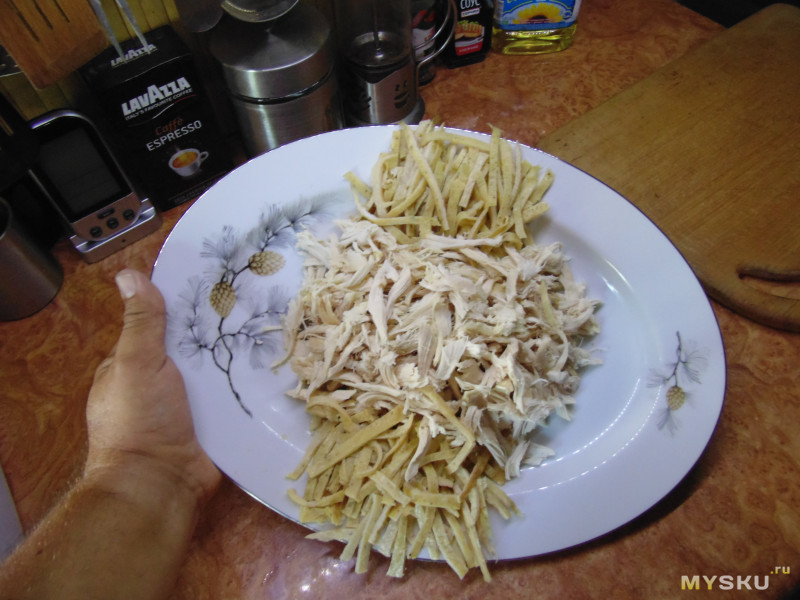
6. Then we cut the remaining elements of the lettuce body into thin strips and place them alternately on a dish. Of course, this time I used a slicer for shredding. 
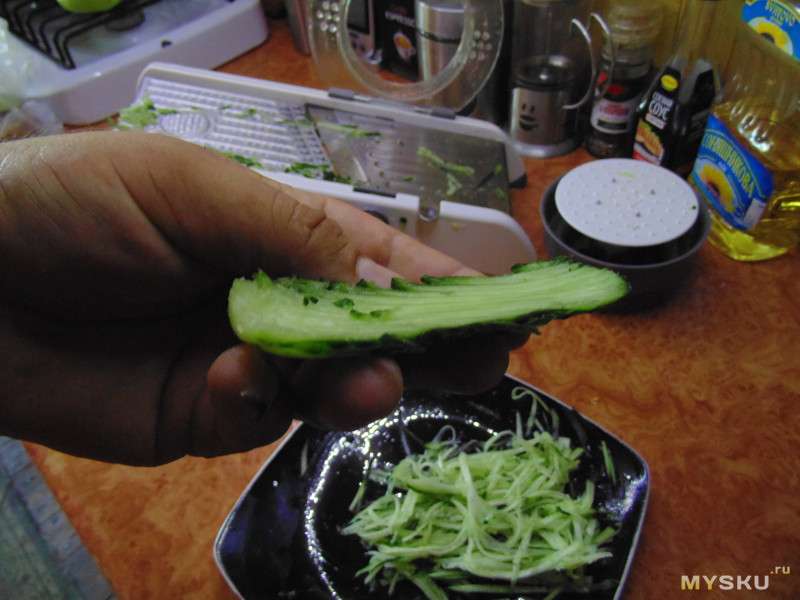
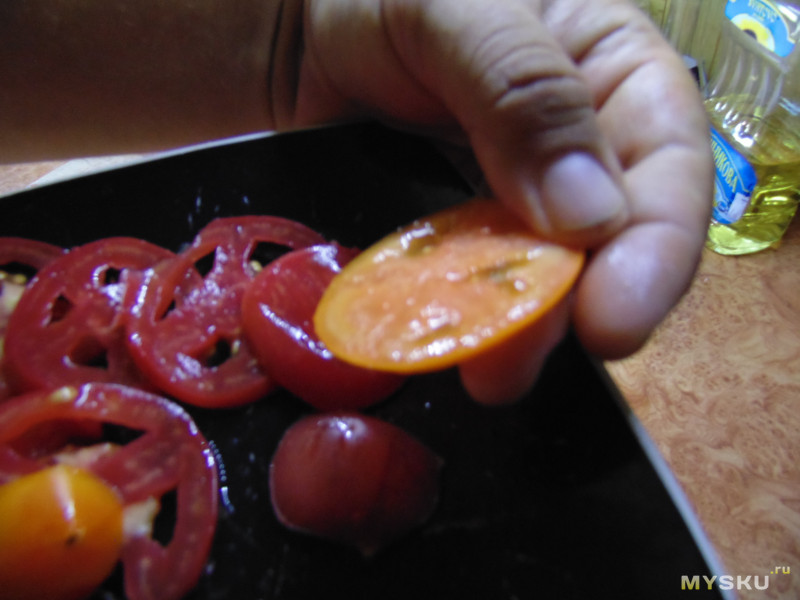
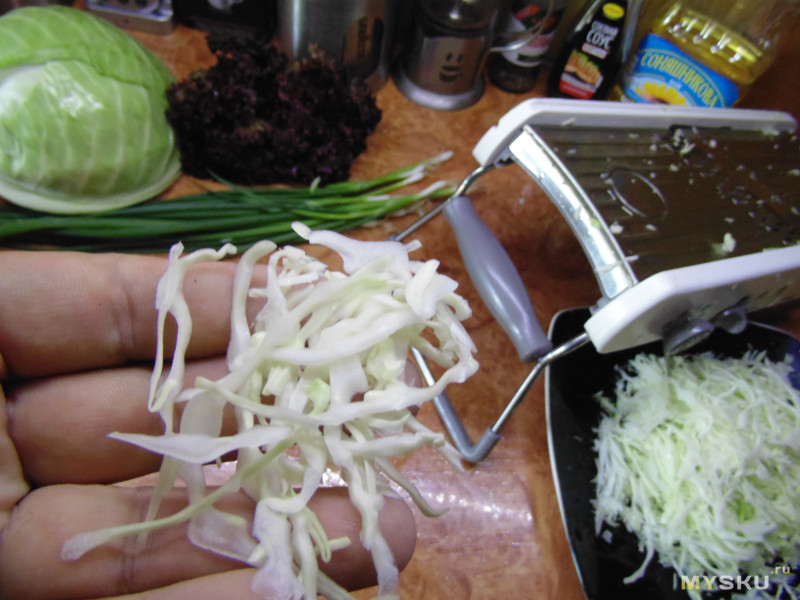
7. Something similar should turn out. 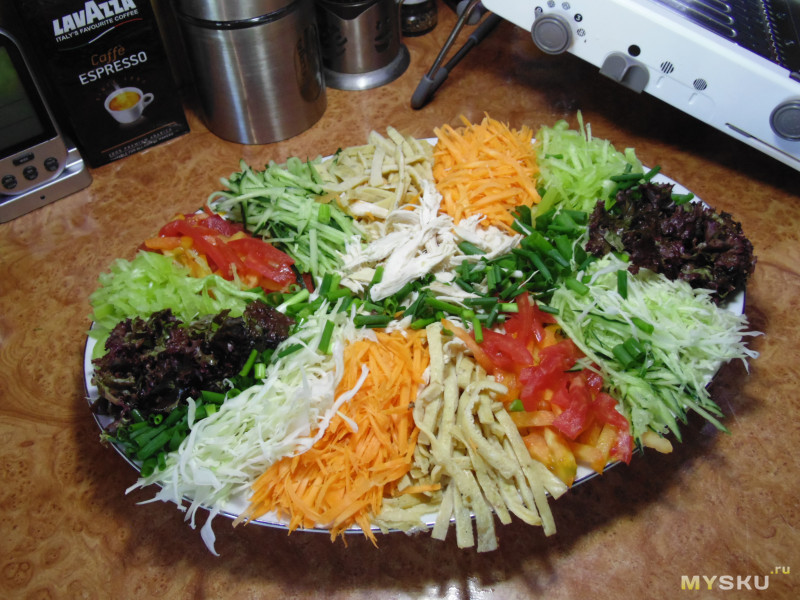
8. I serve salad on the table in such an elegant form. And already here I fill it with real sauce and mix with two forks. The guests love it. 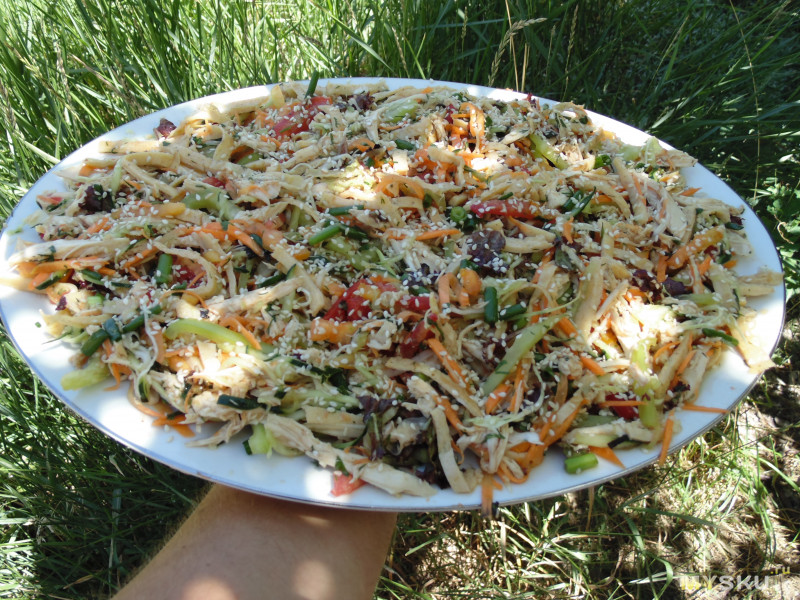
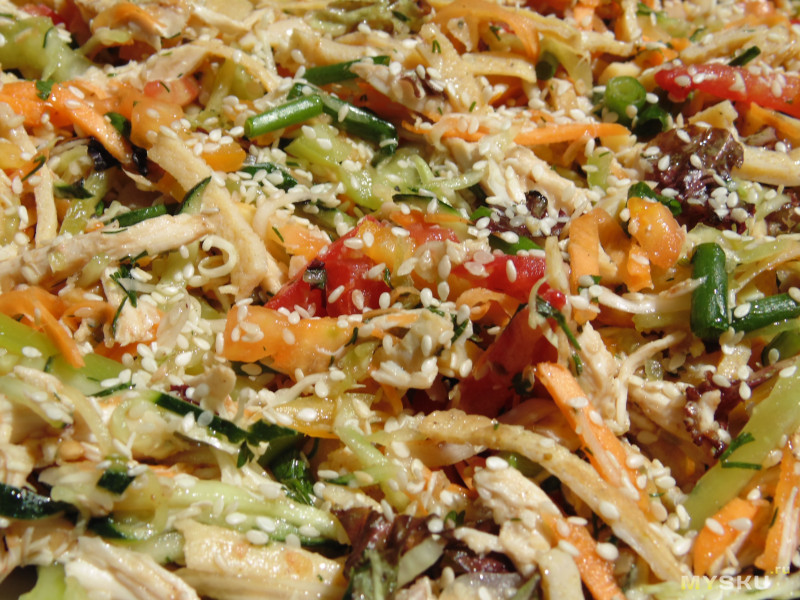
That's all. Conclusions, I think, everyone will make for himself. In the review I tried to tell everything. If you have any questions - well, you know ...
Here are some more videos for you.
Thanks for attention.
Sincerely, Anton.
The product was provided for writing a review by the store. The review is published in accordance with clause 18 of the Site Rules.
I plan to buy +54 Add to favourites Liked the review +37 +86When cooking, after washing and cleaning, the vegetables are cut.
Vegetables are homogeneous, equally cut in shape and size, and when cooked, they simultaneously reach readiness, thereby giving the dish a beautiful appearance when served.
Exist different types slicing vegetables curly and simple, you can also plan and chop vegetables, in addition, vegetables can be cut into a notch, turned.
How to cut vegetables
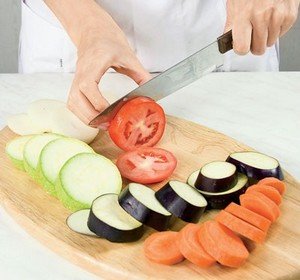
Vegetables are cut by machine or by hand with small and medium knives (if you take a set of chef's three). The most common forms of such cutting are: sticks, straws, circles. cubes, slices, squares, slices, rings and half rings.
Straw
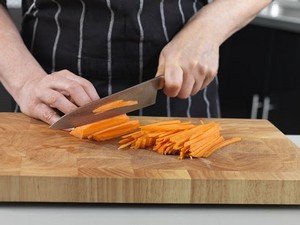
Root crops and potatoes are cut into thin plates, and then into strips (straws). Straws, depending on the purpose, can be very thin (for example, for potatoes that will be deep-fried) and medium (for example, for sautéing root crops). cabbage and onion cut across with a knife by hand, thereby giving them the shape of straws.
Cubes
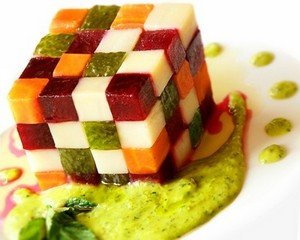
Root crops and potatoes are cut into plates, which are then cut into sticks, and then the sticks are cut into cubes. Depending on the purpose, root crops can be cut into larger cubes (for example, potatoes), medium ones (for example, root crops and potatoes) and small ones (onions and root crops).
Blocks

Potatoes and root crops are cut into plump plates, then they are cut into sticks. For a clear vegetable broth, root vegetables are cut into thin sticks.
Circles
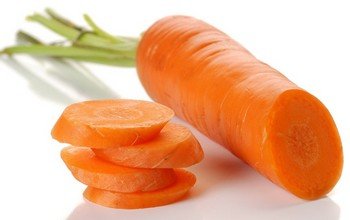
A thin layer is cut off from potatoes and root crops, thereby giving them the shape of a cylinder, then cut into circles. With such cutting, it is better to take root crops of equal diameter.
slices
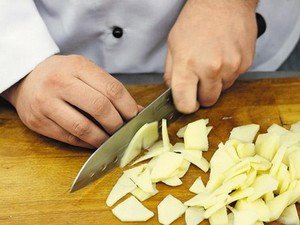
Depending on the size, potatoes and root crops are cut into 4 or 2 parts lengthwise, then each part is cut into slices.
Squares (checkers)
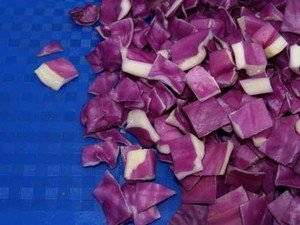
White cabbage is cut into 4 or 2 parts. Then pieces of square shapes are cut from each part.
Slices
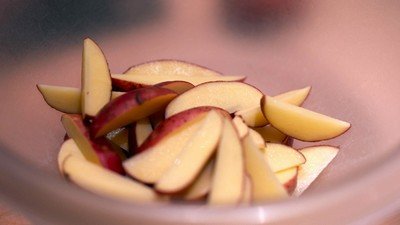
Root crops are cut across into parts, which are then cut into several parts. Onions and potatoes are cut into 4, 6 or more parts, it all depends on the size and their further use in cooking.
Half rings and rings
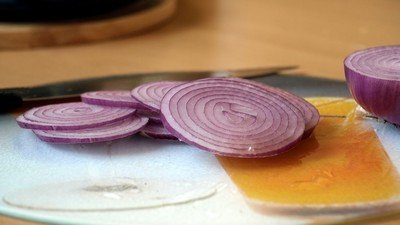
Leek and onion are cut across their axis into circles, then divided into rings. To get half rings, the rings are cut in half.
Karbovanie (curly cutting)
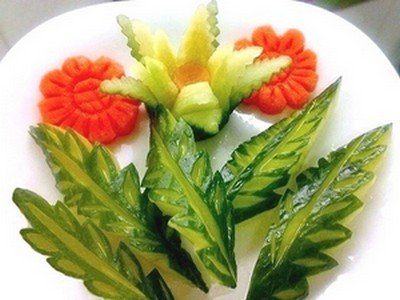
Vegetables, such as carrots, are often cut in the form of stars, or scallops and gears. Use for cutting a regular or corrugated (carbovochny) knife. Carbing is an element.
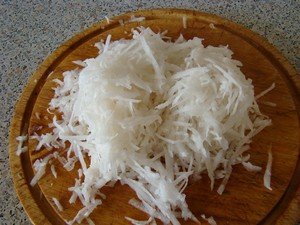
The roots of radish, horseradish are cut with a sharp knife to obtain particles in the form of shavings.
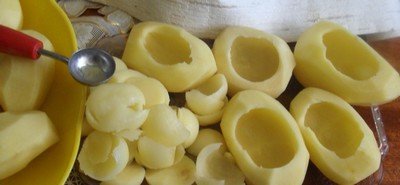
Potatoes and root vegetables are cut with special metal spoons (notches) of various sizes in the form of nuts or balls. To do this, a recess (special spoon) is applied with a sharp edge to the vegetable and gradually rotational movements deepen into potatoes or root crops.
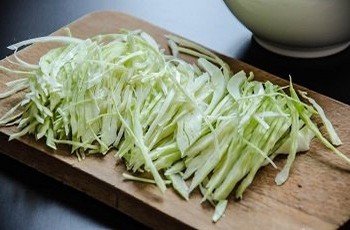
Chopped finely sauerkraut or sauerkraut, onion, garlic, carrots are chopped with a chop or a knife into small pieces, while using a wooden board. It is better to chop (cut) greens with a knife, as it is lost during cutting a large number of moisture, due to which the taste of greens worsens, in addition, it is inconvenient to sprinkle already cooked dishes with wet greens.
Professional chefs have such a thing as a big trio. Large, medium and small knife. The fourth knife is for cutting bread. In order for the dishes to look aesthetically pleasing and beautiful, you should choose a knife for artistic cutting of vegetables to the main knives.It is considered that the most the best are forged knives. Knives for cutting vegetables and fruits have a curved blade. For cleaning and shaping the cut, you need a slingshot-shaped knife. A special curly knife designed for curly cutting will help turn tomatoes into a rose, and cucumber herringbone.
Carving knives
The kit for carving, as a rule, includes the following knives:- Thai knife for curly cutting, giving relief;
- a short knife for cutting flowers;
- table medium knife, designed for large cutting of vegetables and fruits;
- a triangular karbovochny knife gives a triangular relief, it can be of different sizes;
- semi-circular carving knife gives an oval shape, used for cutting flowers;
- a noisette spoon is intended for stripping vegetables and for making balls;
- vegetable peeler;
- small scissors;
- musat created for knife sharpening and scissors.
What you need to know about cutting knives
Regardless of what this or that knife is intended for, it must have a quality blade. It is the blade that helps to easily form various figures, cut fruits into sectors, while simultaneously removing the core. A knife with a blade for cutting vegetables will allow you to quickly and beautifully cut food into cubes. for salads and soups.In order to preserve vitamins when cutting food, you need to use knives with multiple coatings that are resistant to corrosion and rust. A set of figured knives is usually made of of stainless steel. Such blades do not oxidize and do not dull. The handle is also an important element of the knife. It can be metal, wood or plastic.
When choosing knives, you should pay attention to the material of the blade. There may be several options here. The knives made of steel by laser hardening are able to retain their original properties for the longest time. Although in Lately more and more consumers are leaning towards the choice of ceramic appliances. But are these knives really that good in practice? It is impossible to cut solid products with their help, wash in dishwasher also impossible, on a knife








